Strategic Operations Analysis of ASOS: Customer Needs and Strategies
VerifiedAdded on 2019/12/04
|18
|5135
|46
Report
AI Summary
This report provides a comprehensive analysis of ASOS's operational strategies, focusing on its strategic approach to meet customer needs within the retail clothing industry. It examines the application of strategic concepts, including the transformation process model and the 4Vs of operation management, to understand ASOS's efficiency and customer satisfaction. The report analyzes the link between performance objectives and company strategies, identifying key order winners and qualifiers. It also assesses the company's strengths and weaknesses, suggesting improvements to enhance operational efficiency and profitability. The report uses both primary and secondary data sources, including a case study analysis, to provide insights into ASOS's market positioning and competitive landscape. It concludes with recommendations for improving ASOS's operational strategies to adapt to market changes and maintain a competitive advantage. The report covers various aspects of the business, including environmental factors, business strategies, core processes, and organizational culture.
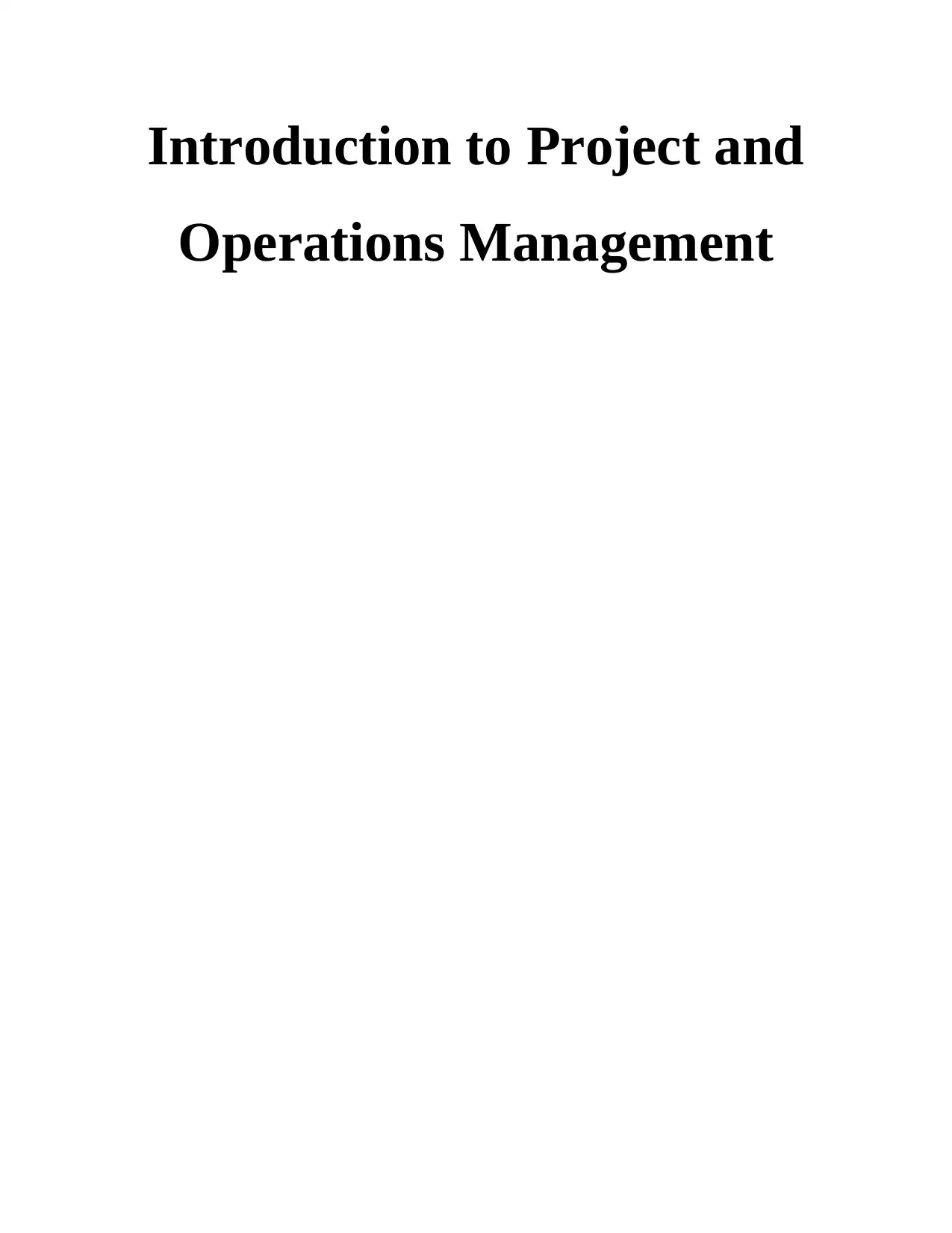
Introduction to Project and
Operations Management
Operations Management
Secure Best Marks with AI Grader
Need help grading? Try our AI Grader for instant feedback on your assignments.
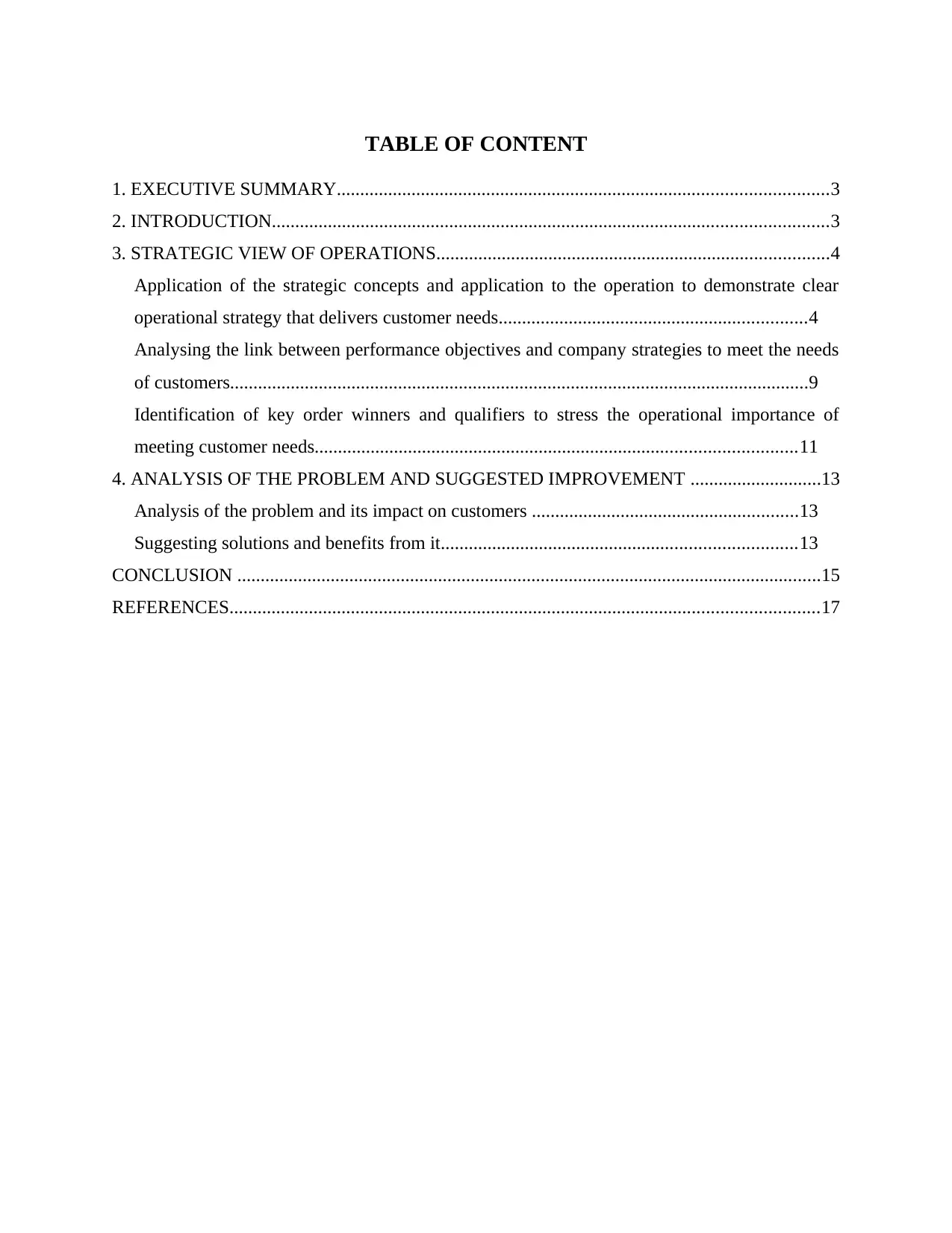
TABLE OF CONTENT
1. EXECUTIVE SUMMARY.........................................................................................................3
2. INTRODUCTION.......................................................................................................................3
3. STRATEGIC VIEW OF OPERATIONS....................................................................................4
Application of the strategic concepts and application to the operation to demonstrate clear
operational strategy that delivers customer needs..................................................................4
Analysing the link between performance objectives and company strategies to meet the needs
of customers............................................................................................................................9
Identification of key order winners and qualifiers to stress the operational importance of
meeting customer needs.......................................................................................................11
4. ANALYSIS OF THE PROBLEM AND SUGGESTED IMPROVEMENT ............................13
Analysis of the problem and its impact on customers .........................................................13
Suggesting solutions and benefits from it............................................................................13
CONCLUSION .............................................................................................................................15
REFERENCES..............................................................................................................................17
1. EXECUTIVE SUMMARY.........................................................................................................3
2. INTRODUCTION.......................................................................................................................3
3. STRATEGIC VIEW OF OPERATIONS....................................................................................4
Application of the strategic concepts and application to the operation to demonstrate clear
operational strategy that delivers customer needs..................................................................4
Analysing the link between performance objectives and company strategies to meet the needs
of customers............................................................................................................................9
Identification of key order winners and qualifiers to stress the operational importance of
meeting customer needs.......................................................................................................11
4. ANALYSIS OF THE PROBLEM AND SUGGESTED IMPROVEMENT ............................13
Analysis of the problem and its impact on customers .........................................................13
Suggesting solutions and benefits from it............................................................................13
CONCLUSION .............................................................................................................................15
REFERENCES..............................................................................................................................17
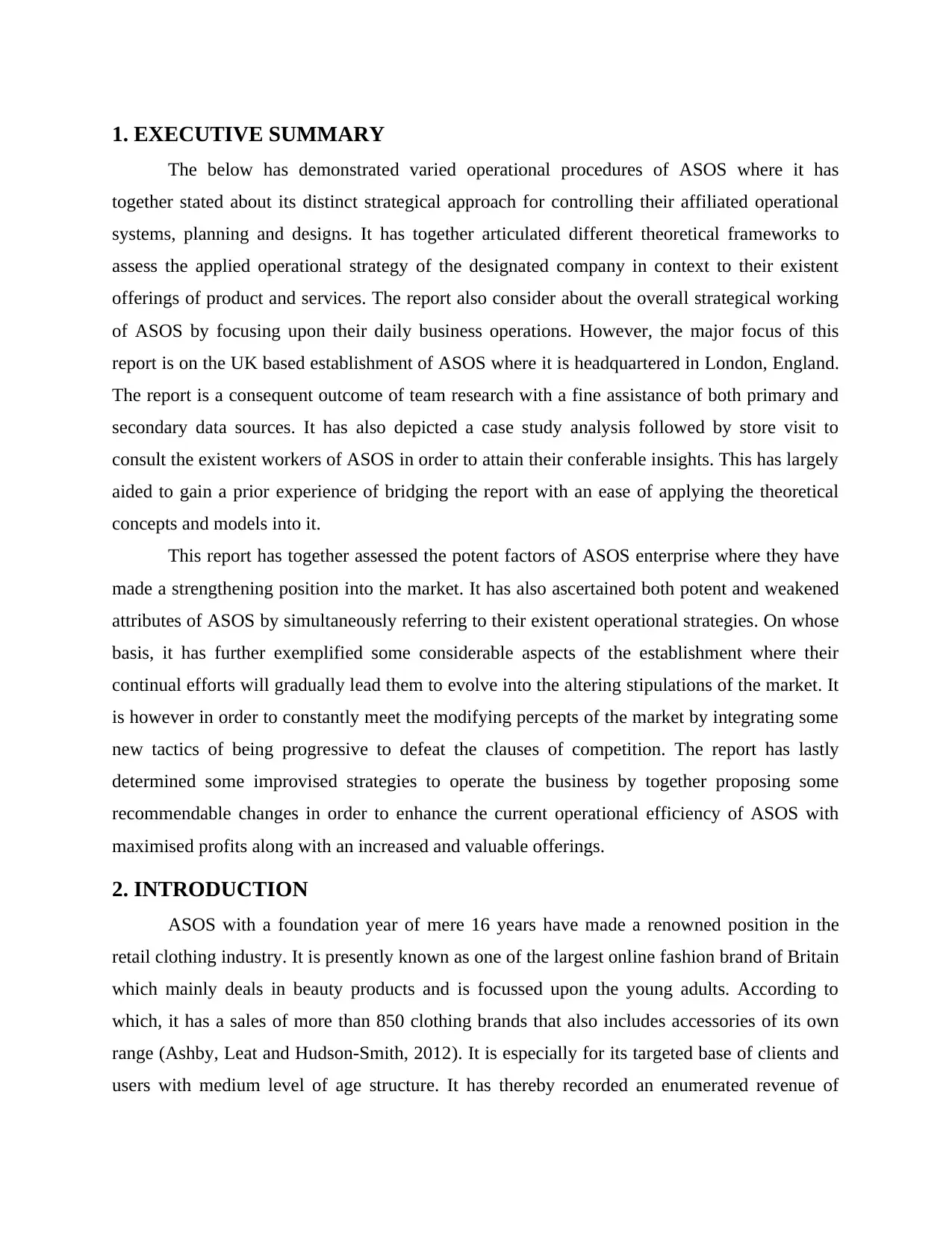
1. EXECUTIVE SUMMARY
The below has demonstrated varied operational procedures of ASOS where it has
together stated about its distinct strategical approach for controlling their affiliated operational
systems, planning and designs. It has together articulated different theoretical frameworks to
assess the applied operational strategy of the designated company in context to their existent
offerings of product and services. The report also consider about the overall strategical working
of ASOS by focusing upon their daily business operations. However, the major focus of this
report is on the UK based establishment of ASOS where it is headquartered in London, England.
The report is a consequent outcome of team research with a fine assistance of both primary and
secondary data sources. It has also depicted a case study analysis followed by store visit to
consult the existent workers of ASOS in order to attain their conferable insights. This has largely
aided to gain a prior experience of bridging the report with an ease of applying the theoretical
concepts and models into it.
This report has together assessed the potent factors of ASOS enterprise where they have
made a strengthening position into the market. It has also ascertained both potent and weakened
attributes of ASOS by simultaneously referring to their existent operational strategies. On whose
basis, it has further exemplified some considerable aspects of the establishment where their
continual efforts will gradually lead them to evolve into the altering stipulations of the market. It
is however in order to constantly meet the modifying percepts of the market by integrating some
new tactics of being progressive to defeat the clauses of competition. The report has lastly
determined some improvised strategies to operate the business by together proposing some
recommendable changes in order to enhance the current operational efficiency of ASOS with
maximised profits along with an increased and valuable offerings.
2. INTRODUCTION
ASOS with a foundation year of mere 16 years have made a renowned position in the
retail clothing industry. It is presently known as one of the largest online fashion brand of Britain
which mainly deals in beauty products and is focussed upon the young adults. According to
which, it has a sales of more than 850 clothing brands that also includes accessories of its own
range (Ashby, Leat and Hudson-Smith, 2012). It is especially for its targeted base of clients and
users with medium level of age structure. It has thereby recorded an enumerated revenue of
The below has demonstrated varied operational procedures of ASOS where it has
together stated about its distinct strategical approach for controlling their affiliated operational
systems, planning and designs. It has together articulated different theoretical frameworks to
assess the applied operational strategy of the designated company in context to their existent
offerings of product and services. The report also consider about the overall strategical working
of ASOS by focusing upon their daily business operations. However, the major focus of this
report is on the UK based establishment of ASOS where it is headquartered in London, England.
The report is a consequent outcome of team research with a fine assistance of both primary and
secondary data sources. It has also depicted a case study analysis followed by store visit to
consult the existent workers of ASOS in order to attain their conferable insights. This has largely
aided to gain a prior experience of bridging the report with an ease of applying the theoretical
concepts and models into it.
This report has together assessed the potent factors of ASOS enterprise where they have
made a strengthening position into the market. It has also ascertained both potent and weakened
attributes of ASOS by simultaneously referring to their existent operational strategies. On whose
basis, it has further exemplified some considerable aspects of the establishment where their
continual efforts will gradually lead them to evolve into the altering stipulations of the market. It
is however in order to constantly meet the modifying percepts of the market by integrating some
new tactics of being progressive to defeat the clauses of competition. The report has lastly
determined some improvised strategies to operate the business by together proposing some
recommendable changes in order to enhance the current operational efficiency of ASOS with
maximised profits along with an increased and valuable offerings.
2. INTRODUCTION
ASOS with a foundation year of mere 16 years have made a renowned position in the
retail clothing industry. It is presently known as one of the largest online fashion brand of Britain
which mainly deals in beauty products and is focussed upon the young adults. According to
which, it has a sales of more than 850 clothing brands that also includes accessories of its own
range (Ashby, Leat and Hudson-Smith, 2012). It is especially for its targeted base of clients and
users with medium level of age structure. It has thereby recorded an enumerated revenue of
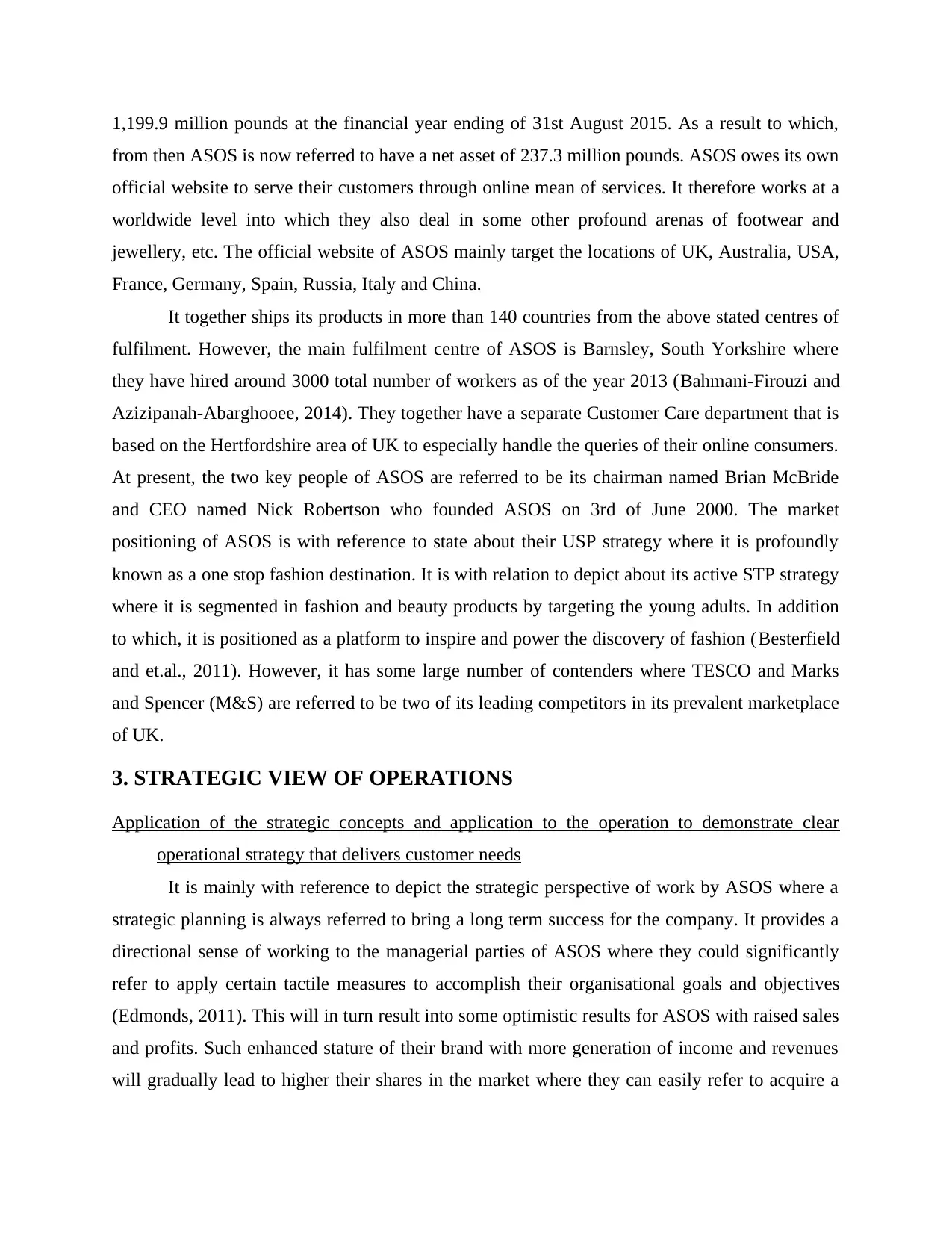
1,199.9 million pounds at the financial year ending of 31st August 2015. As a result to which,
from then ASOS is now referred to have a net asset of 237.3 million pounds. ASOS owes its own
official website to serve their customers through online mean of services. It therefore works at a
worldwide level into which they also deal in some other profound arenas of footwear and
jewellery, etc. The official website of ASOS mainly target the locations of UK, Australia, USA,
France, Germany, Spain, Russia, Italy and China.
It together ships its products in more than 140 countries from the above stated centres of
fulfilment. However, the main fulfilment centre of ASOS is Barnsley, South Yorkshire where
they have hired around 3000 total number of workers as of the year 2013 (Bahmani-Firouzi and
Azizipanah-Abarghooee, 2014). They together have a separate Customer Care department that is
based on the Hertfordshire area of UK to especially handle the queries of their online consumers.
At present, the two key people of ASOS are referred to be its chairman named Brian McBride
and CEO named Nick Robertson who founded ASOS on 3rd of June 2000. The market
positioning of ASOS is with reference to state about their USP strategy where it is profoundly
known as a one stop fashion destination. It is with relation to depict about its active STP strategy
where it is segmented in fashion and beauty products by targeting the young adults. In addition
to which, it is positioned as a platform to inspire and power the discovery of fashion (Besterfield
and et.al., 2011). However, it has some large number of contenders where TESCO and Marks
and Spencer (M&S) are referred to be two of its leading competitors in its prevalent marketplace
of UK.
3. STRATEGIC VIEW OF OPERATIONS
Application of the strategic concepts and application to the operation to demonstrate clear
operational strategy that delivers customer needs
It is mainly with reference to depict the strategic perspective of work by ASOS where a
strategic planning is always referred to bring a long term success for the company. It provides a
directional sense of working to the managerial parties of ASOS where they could significantly
refer to apply certain tactile measures to accomplish their organisational goals and objectives
(Edmonds, 2011). This will in turn result into some optimistic results for ASOS with raised sales
and profits. Such enhanced stature of their brand with more generation of income and revenues
will gradually lead to higher their shares in the market where they can easily refer to acquire a
from then ASOS is now referred to have a net asset of 237.3 million pounds. ASOS owes its own
official website to serve their customers through online mean of services. It therefore works at a
worldwide level into which they also deal in some other profound arenas of footwear and
jewellery, etc. The official website of ASOS mainly target the locations of UK, Australia, USA,
France, Germany, Spain, Russia, Italy and China.
It together ships its products in more than 140 countries from the above stated centres of
fulfilment. However, the main fulfilment centre of ASOS is Barnsley, South Yorkshire where
they have hired around 3000 total number of workers as of the year 2013 (Bahmani-Firouzi and
Azizipanah-Abarghooee, 2014). They together have a separate Customer Care department that is
based on the Hertfordshire area of UK to especially handle the queries of their online consumers.
At present, the two key people of ASOS are referred to be its chairman named Brian McBride
and CEO named Nick Robertson who founded ASOS on 3rd of June 2000. The market
positioning of ASOS is with reference to state about their USP strategy where it is profoundly
known as a one stop fashion destination. It is with relation to depict about its active STP strategy
where it is segmented in fashion and beauty products by targeting the young adults. In addition
to which, it is positioned as a platform to inspire and power the discovery of fashion (Besterfield
and et.al., 2011). However, it has some large number of contenders where TESCO and Marks
and Spencer (M&S) are referred to be two of its leading competitors in its prevalent marketplace
of UK.
3. STRATEGIC VIEW OF OPERATIONS
Application of the strategic concepts and application to the operation to demonstrate clear
operational strategy that delivers customer needs
It is mainly with reference to depict the strategic perspective of work by ASOS where a
strategic planning is always referred to bring a long term success for the company. It provides a
directional sense of working to the managerial parties of ASOS where they could significantly
refer to apply certain tactile measures to accomplish their organisational goals and objectives
(Edmonds, 2011). This will in turn result into some optimistic results for ASOS with raised sales
and profits. Such enhanced stature of their brand with more generation of income and revenues
will gradually lead to higher their shares in the market where they can easily refer to acquire a
Secure Best Marks with AI Grader
Need help grading? Try our AI Grader for instant feedback on your assignments.
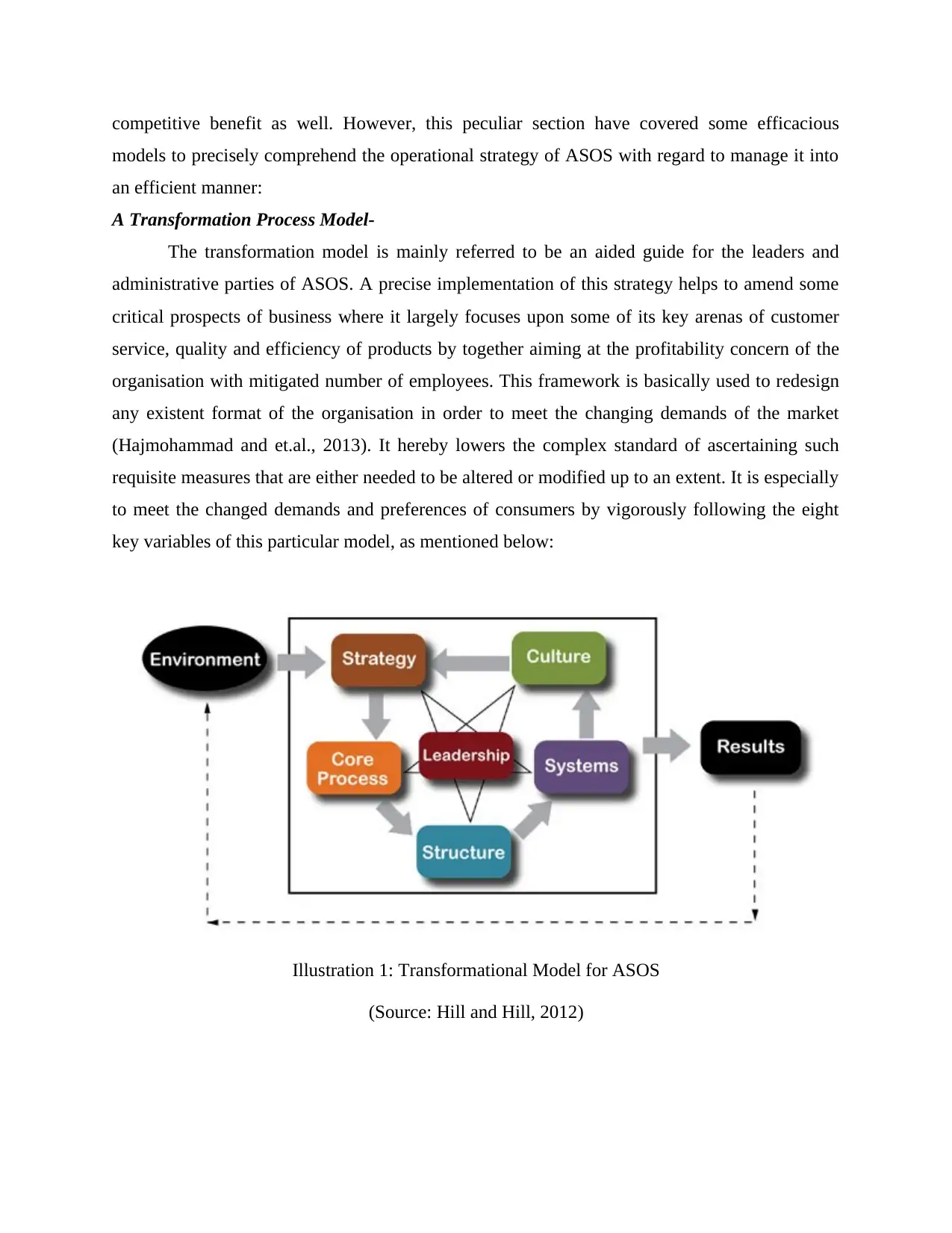
competitive benefit as well. However, this peculiar section have covered some efficacious
models to precisely comprehend the operational strategy of ASOS with regard to manage it into
an efficient manner:
A Transformation Process Model-
The transformation model is mainly referred to be an aided guide for the leaders and
administrative parties of ASOS. A precise implementation of this strategy helps to amend some
critical prospects of business where it largely focuses upon some of its key arenas of customer
service, quality and efficiency of products by together aiming at the profitability concern of the
organisation with mitigated number of employees. This framework is basically used to redesign
any existent format of the organisation in order to meet the changing demands of the market
(Hajmohammad and et.al., 2013). It hereby lowers the complex standard of ascertaining such
requisite measures that are either needed to be altered or modified up to an extent. It is especially
to meet the changed demands and preferences of consumers by vigorously following the eight
key variables of this particular model, as mentioned below:
Illustration 1: Transformational Model for ASOS
(Source: Hill and Hill, 2012)
models to precisely comprehend the operational strategy of ASOS with regard to manage it into
an efficient manner:
A Transformation Process Model-
The transformation model is mainly referred to be an aided guide for the leaders and
administrative parties of ASOS. A precise implementation of this strategy helps to amend some
critical prospects of business where it largely focuses upon some of its key arenas of customer
service, quality and efficiency of products by together aiming at the profitability concern of the
organisation with mitigated number of employees. This framework is basically used to redesign
any existent format of the organisation in order to meet the changing demands of the market
(Hajmohammad and et.al., 2013). It hereby lowers the complex standard of ascertaining such
requisite measures that are either needed to be altered or modified up to an extent. It is especially
to meet the changed demands and preferences of consumers by vigorously following the eight
key variables of this particular model, as mentioned below:
Illustration 1: Transformational Model for ASOS
(Source: Hill and Hill, 2012)
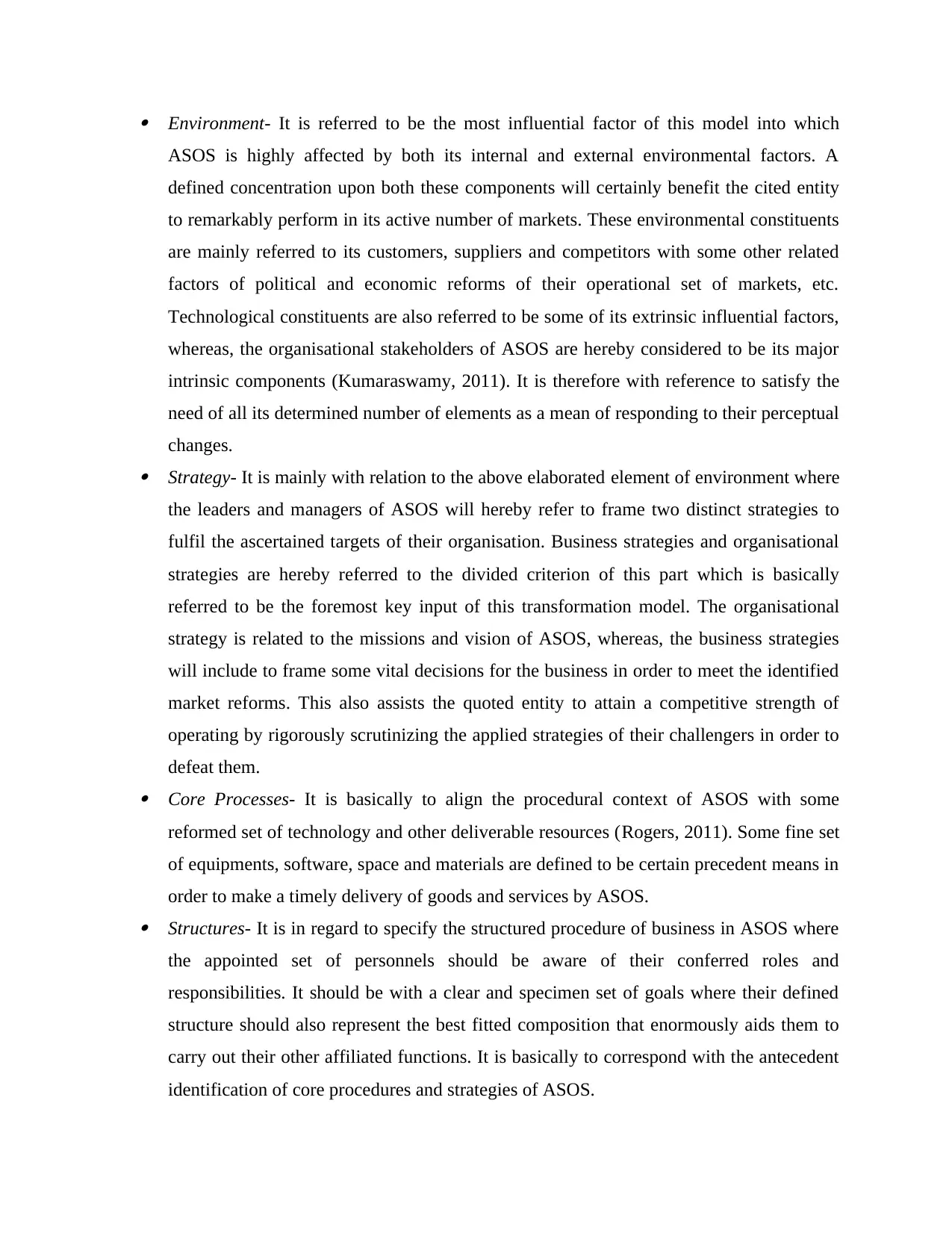
Environment- It is referred to be the most influential factor of this model into which
ASOS is highly affected by both its internal and external environmental factors. A
defined concentration upon both these components will certainly benefit the cited entity
to remarkably perform in its active number of markets. These environmental constituents
are mainly referred to its customers, suppliers and competitors with some other related
factors of political and economic reforms of their operational set of markets, etc.
Technological constituents are also referred to be some of its extrinsic influential factors,
whereas, the organisational stakeholders of ASOS are hereby considered to be its major
intrinsic components (Kumaraswamy, 2011). It is therefore with reference to satisfy the
need of all its determined number of elements as a mean of responding to their perceptual
changes. Strategy- It is mainly with relation to the above elaborated element of environment where
the leaders and managers of ASOS will hereby refer to frame two distinct strategies to
fulfil the ascertained targets of their organisation. Business strategies and organisational
strategies are hereby referred to the divided criterion of this part which is basically
referred to be the foremost key input of this transformation model. The organisational
strategy is related to the missions and vision of ASOS, whereas, the business strategies
will include to frame some vital decisions for the business in order to meet the identified
market reforms. This also assists the quoted entity to attain a competitive strength of
operating by rigorously scrutinizing the applied strategies of their challengers in order to
defeat them. Core Processes- It is basically to align the procedural context of ASOS with some
reformed set of technology and other deliverable resources (Rogers, 2011). Some fine set
of equipments, software, space and materials are defined to be certain precedent means in
order to make a timely delivery of goods and services by ASOS. Structures- It is in regard to specify the structured procedure of business in ASOS where
the appointed set of personnels should be aware of their conferred roles and
responsibilities. It should be with a clear and specimen set of goals where their defined
structure should also represent the best fitted composition that enormously aids them to
carry out their other affiliated functions. It is basically to correspond with the antecedent
identification of core procedures and strategies of ASOS.
ASOS is highly affected by both its internal and external environmental factors. A
defined concentration upon both these components will certainly benefit the cited entity
to remarkably perform in its active number of markets. These environmental constituents
are mainly referred to its customers, suppliers and competitors with some other related
factors of political and economic reforms of their operational set of markets, etc.
Technological constituents are also referred to be some of its extrinsic influential factors,
whereas, the organisational stakeholders of ASOS are hereby considered to be its major
intrinsic components (Kumaraswamy, 2011). It is therefore with reference to satisfy the
need of all its determined number of elements as a mean of responding to their perceptual
changes. Strategy- It is mainly with relation to the above elaborated element of environment where
the leaders and managers of ASOS will hereby refer to frame two distinct strategies to
fulfil the ascertained targets of their organisation. Business strategies and organisational
strategies are hereby referred to the divided criterion of this part which is basically
referred to be the foremost key input of this transformation model. The organisational
strategy is related to the missions and vision of ASOS, whereas, the business strategies
will include to frame some vital decisions for the business in order to meet the identified
market reforms. This also assists the quoted entity to attain a competitive strength of
operating by rigorously scrutinizing the applied strategies of their challengers in order to
defeat them. Core Processes- It is basically to align the procedural context of ASOS with some
reformed set of technology and other deliverable resources (Rogers, 2011). Some fine set
of equipments, software, space and materials are defined to be certain precedent means in
order to make a timely delivery of goods and services by ASOS. Structures- It is in regard to specify the structured procedure of business in ASOS where
the appointed set of personnels should be aware of their conferred roles and
responsibilities. It should be with a clear and specimen set of goals where their defined
structure should also represent the best fitted composition that enormously aids them to
carry out their other affiliated functions. It is basically to correspond with the antecedent
identification of core procedures and strategies of ASOS.
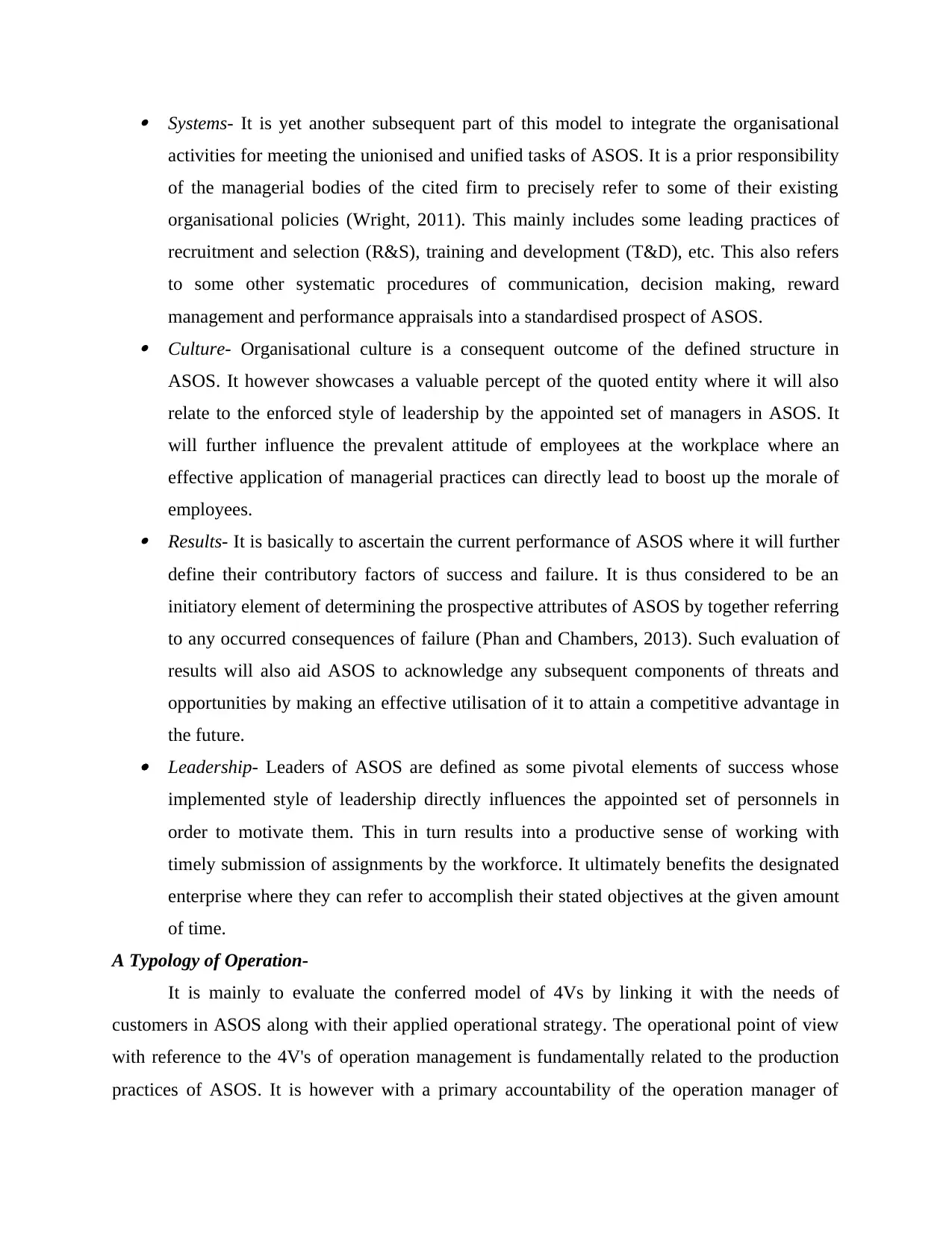
Systems- It is yet another subsequent part of this model to integrate the organisational
activities for meeting the unionised and unified tasks of ASOS. It is a prior responsibility
of the managerial bodies of the cited firm to precisely refer to some of their existing
organisational policies (Wright, 2011). This mainly includes some leading practices of
recruitment and selection (R&S), training and development (T&D), etc. This also refers
to some other systematic procedures of communication, decision making, reward
management and performance appraisals into a standardised prospect of ASOS. Culture- Organisational culture is a consequent outcome of the defined structure in
ASOS. It however showcases a valuable percept of the quoted entity where it will also
relate to the enforced style of leadership by the appointed set of managers in ASOS. It
will further influence the prevalent attitude of employees at the workplace where an
effective application of managerial practices can directly lead to boost up the morale of
employees. Results- It is basically to ascertain the current performance of ASOS where it will further
define their contributory factors of success and failure. It is thus considered to be an
initiatory element of determining the prospective attributes of ASOS by together referring
to any occurred consequences of failure (Phan and Chambers, 2013). Such evaluation of
results will also aid ASOS to acknowledge any subsequent components of threats and
opportunities by making an effective utilisation of it to attain a competitive advantage in
the future. Leadership- Leaders of ASOS are defined as some pivotal elements of success whose
implemented style of leadership directly influences the appointed set of personnels in
order to motivate them. This in turn results into a productive sense of working with
timely submission of assignments by the workforce. It ultimately benefits the designated
enterprise where they can refer to accomplish their stated objectives at the given amount
of time.
A Typology of Operation-
It is mainly to evaluate the conferred model of 4Vs by linking it with the needs of
customers in ASOS along with their applied operational strategy. The operational point of view
with reference to the 4V's of operation management is fundamentally related to the production
practices of ASOS. It is however with a primary accountability of the operation manager of
activities for meeting the unionised and unified tasks of ASOS. It is a prior responsibility
of the managerial bodies of the cited firm to precisely refer to some of their existing
organisational policies (Wright, 2011). This mainly includes some leading practices of
recruitment and selection (R&S), training and development (T&D), etc. This also refers
to some other systematic procedures of communication, decision making, reward
management and performance appraisals into a standardised prospect of ASOS. Culture- Organisational culture is a consequent outcome of the defined structure in
ASOS. It however showcases a valuable percept of the quoted entity where it will also
relate to the enforced style of leadership by the appointed set of managers in ASOS. It
will further influence the prevalent attitude of employees at the workplace where an
effective application of managerial practices can directly lead to boost up the morale of
employees. Results- It is basically to ascertain the current performance of ASOS where it will further
define their contributory factors of success and failure. It is thus considered to be an
initiatory element of determining the prospective attributes of ASOS by together referring
to any occurred consequences of failure (Phan and Chambers, 2013). Such evaluation of
results will also aid ASOS to acknowledge any subsequent components of threats and
opportunities by making an effective utilisation of it to attain a competitive advantage in
the future. Leadership- Leaders of ASOS are defined as some pivotal elements of success whose
implemented style of leadership directly influences the appointed set of personnels in
order to motivate them. This in turn results into a productive sense of working with
timely submission of assignments by the workforce. It ultimately benefits the designated
enterprise where they can refer to accomplish their stated objectives at the given amount
of time.
A Typology of Operation-
It is mainly to evaluate the conferred model of 4Vs by linking it with the needs of
customers in ASOS along with their applied operational strategy. The operational point of view
with reference to the 4V's of operation management is fundamentally related to the production
practices of ASOS. It is however with a primary accountability of the operation manager of
Paraphrase This Document
Need a fresh take? Get an instant paraphrase of this document with our AI Paraphraser
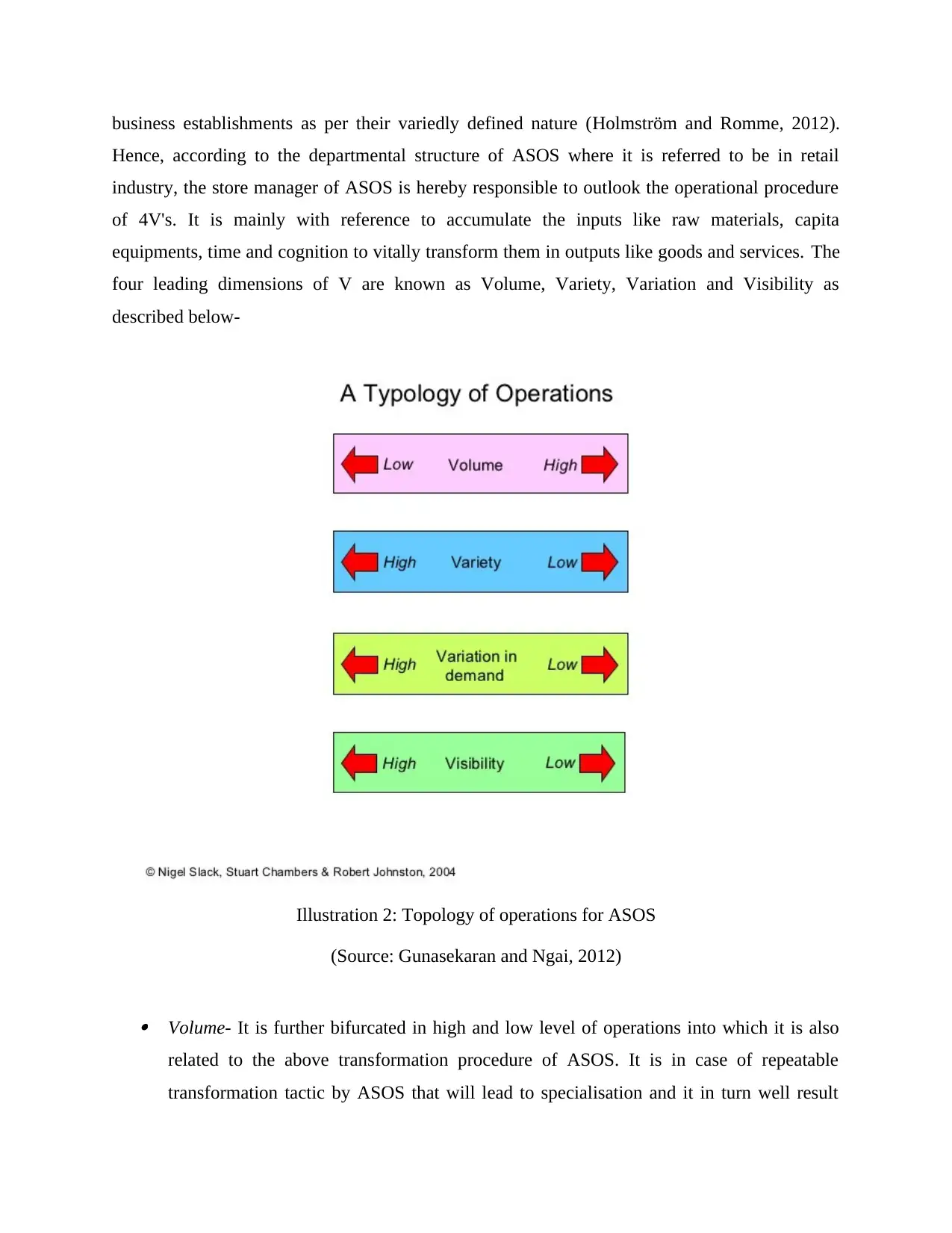
business establishments as per their variedly defined nature (Holmström and Romme, 2012).
Hence, according to the departmental structure of ASOS where it is referred to be in retail
industry, the store manager of ASOS is hereby responsible to outlook the operational procedure
of 4V's. It is mainly with reference to accumulate the inputs like raw materials, capita
equipments, time and cognition to vitally transform them in outputs like goods and services. The
four leading dimensions of V are known as Volume, Variety, Variation and Visibility as
described below-
Volume- It is further bifurcated in high and low level of operations into which it is also
related to the above transformation procedure of ASOS. It is in case of repeatable
transformation tactic by ASOS that will lead to specialisation and it in turn well result
Illustration 2: Topology of operations for ASOS
(Source: Gunasekaran and Ngai, 2012)
Hence, according to the departmental structure of ASOS where it is referred to be in retail
industry, the store manager of ASOS is hereby responsible to outlook the operational procedure
of 4V's. It is mainly with reference to accumulate the inputs like raw materials, capita
equipments, time and cognition to vitally transform them in outputs like goods and services. The
four leading dimensions of V are known as Volume, Variety, Variation and Visibility as
described below-
Volume- It is further bifurcated in high and low level of operations into which it is also
related to the above transformation procedure of ASOS. It is in case of repeatable
transformation tactic by ASOS that will lead to specialisation and it in turn well result
Illustration 2: Topology of operations for ASOS
(Source: Gunasekaran and Ngai, 2012)
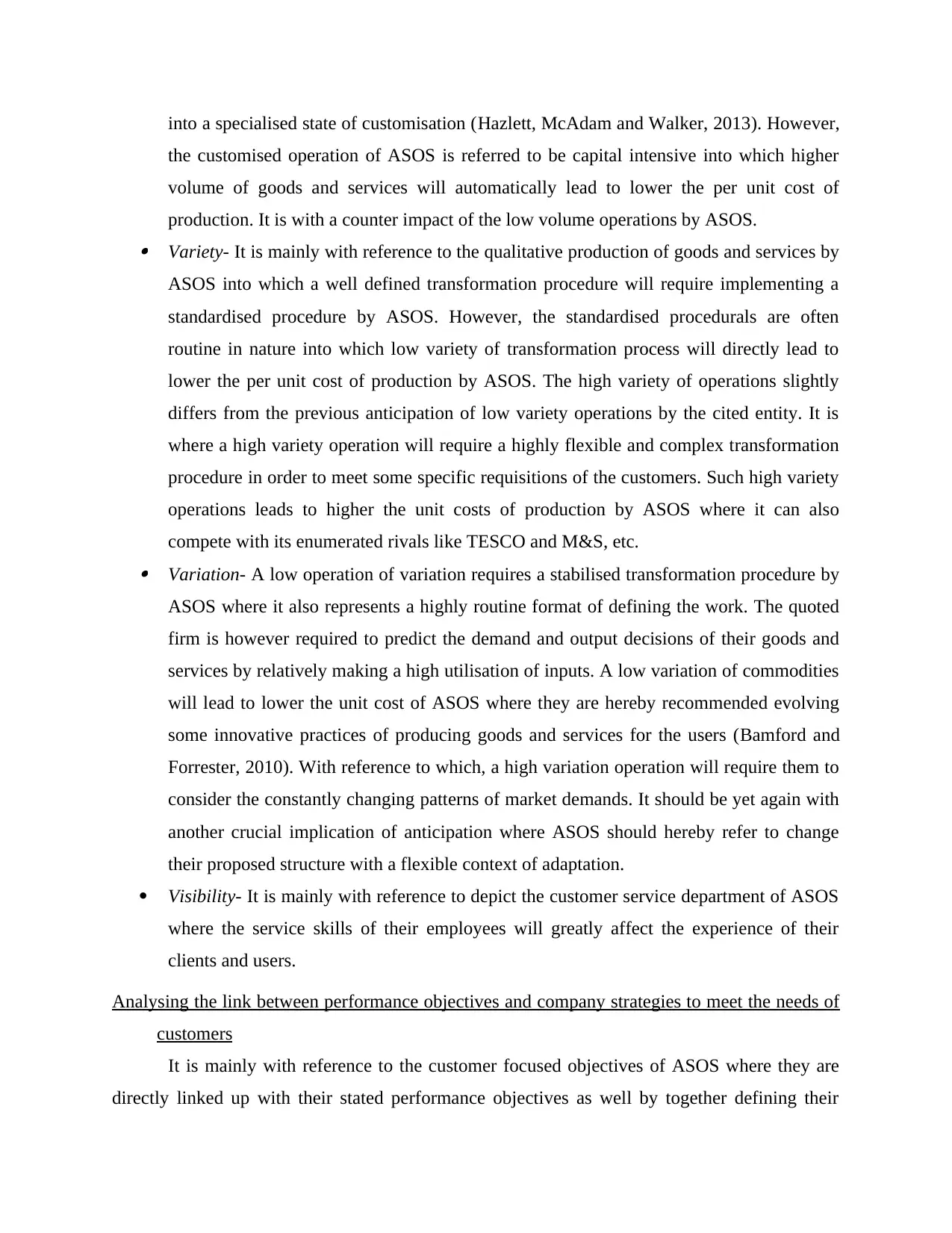
into a specialised state of customisation (Hazlett, McAdam and Walker, 2013). However,
the customised operation of ASOS is referred to be capital intensive into which higher
volume of goods and services will automatically lead to lower the per unit cost of
production. It is with a counter impact of the low volume operations by ASOS. Variety- It is mainly with reference to the qualitative production of goods and services by
ASOS into which a well defined transformation procedure will require implementing a
standardised procedure by ASOS. However, the standardised procedurals are often
routine in nature into which low variety of transformation process will directly lead to
lower the per unit cost of production by ASOS. The high variety of operations slightly
differs from the previous anticipation of low variety operations by the cited entity. It is
where a high variety operation will require a highly flexible and complex transformation
procedure in order to meet some specific requisitions of the customers. Such high variety
operations leads to higher the unit costs of production by ASOS where it can also
compete with its enumerated rivals like TESCO and M&S, etc. Variation- A low operation of variation requires a stabilised transformation procedure by
ASOS where it also represents a highly routine format of defining the work. The quoted
firm is however required to predict the demand and output decisions of their goods and
services by relatively making a high utilisation of inputs. A low variation of commodities
will lead to lower the unit cost of ASOS where they are hereby recommended evolving
some innovative practices of producing goods and services for the users (Bamford and
Forrester, 2010). With reference to which, a high variation operation will require them to
consider the constantly changing patterns of market demands. It should be yet again with
another crucial implication of anticipation where ASOS should hereby refer to change
their proposed structure with a flexible context of adaptation.
Visibility- It is mainly with reference to depict the customer service department of ASOS
where the service skills of their employees will greatly affect the experience of their
clients and users.
Analysing the link between performance objectives and company strategies to meet the needs of
customers
It is mainly with reference to the customer focused objectives of ASOS where they are
directly linked up with their stated performance objectives as well by together defining their
the customised operation of ASOS is referred to be capital intensive into which higher
volume of goods and services will automatically lead to lower the per unit cost of
production. It is with a counter impact of the low volume operations by ASOS. Variety- It is mainly with reference to the qualitative production of goods and services by
ASOS into which a well defined transformation procedure will require implementing a
standardised procedure by ASOS. However, the standardised procedurals are often
routine in nature into which low variety of transformation process will directly lead to
lower the per unit cost of production by ASOS. The high variety of operations slightly
differs from the previous anticipation of low variety operations by the cited entity. It is
where a high variety operation will require a highly flexible and complex transformation
procedure in order to meet some specific requisitions of the customers. Such high variety
operations leads to higher the unit costs of production by ASOS where it can also
compete with its enumerated rivals like TESCO and M&S, etc. Variation- A low operation of variation requires a stabilised transformation procedure by
ASOS where it also represents a highly routine format of defining the work. The quoted
firm is however required to predict the demand and output decisions of their goods and
services by relatively making a high utilisation of inputs. A low variation of commodities
will lead to lower the unit cost of ASOS where they are hereby recommended evolving
some innovative practices of producing goods and services for the users (Bamford and
Forrester, 2010). With reference to which, a high variation operation will require them to
consider the constantly changing patterns of market demands. It should be yet again with
another crucial implication of anticipation where ASOS should hereby refer to change
their proposed structure with a flexible context of adaptation.
Visibility- It is mainly with reference to depict the customer service department of ASOS
where the service skills of their employees will greatly affect the experience of their
clients and users.
Analysing the link between performance objectives and company strategies to meet the needs of
customers
It is mainly with reference to the customer focused objectives of ASOS where they are
directly linked up with their stated performance objectives as well by together defining their
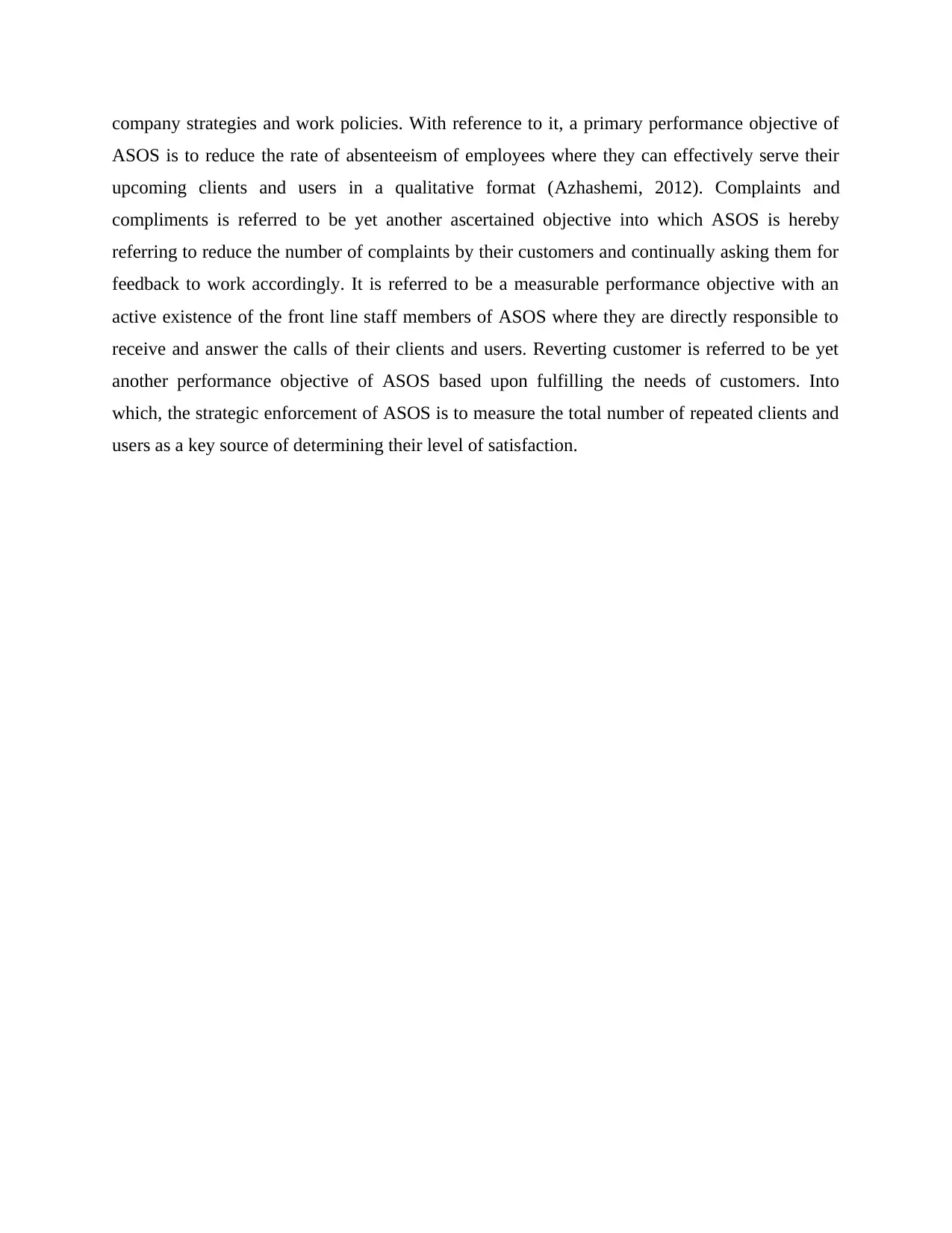
company strategies and work policies. With reference to it, a primary performance objective of
ASOS is to reduce the rate of absenteeism of employees where they can effectively serve their
upcoming clients and users in a qualitative format (Azhashemi, 2012). Complaints and
compliments is referred to be yet another ascertained objective into which ASOS is hereby
referring to reduce the number of complaints by their customers and continually asking them for
feedback to work accordingly. It is referred to be a measurable performance objective with an
active existence of the front line staff members of ASOS where they are directly responsible to
receive and answer the calls of their clients and users. Reverting customer is referred to be yet
another performance objective of ASOS based upon fulfilling the needs of customers. Into
which, the strategic enforcement of ASOS is to measure the total number of repeated clients and
users as a key source of determining their level of satisfaction.
ASOS is to reduce the rate of absenteeism of employees where they can effectively serve their
upcoming clients and users in a qualitative format (Azhashemi, 2012). Complaints and
compliments is referred to be yet another ascertained objective into which ASOS is hereby
referring to reduce the number of complaints by their customers and continually asking them for
feedback to work accordingly. It is referred to be a measurable performance objective with an
active existence of the front line staff members of ASOS where they are directly responsible to
receive and answer the calls of their clients and users. Reverting customer is referred to be yet
another performance objective of ASOS based upon fulfilling the needs of customers. Into
which, the strategic enforcement of ASOS is to measure the total number of repeated clients and
users as a key source of determining their level of satisfaction.
Secure Best Marks with AI Grader
Need help grading? Try our AI Grader for instant feedback on your assignments.
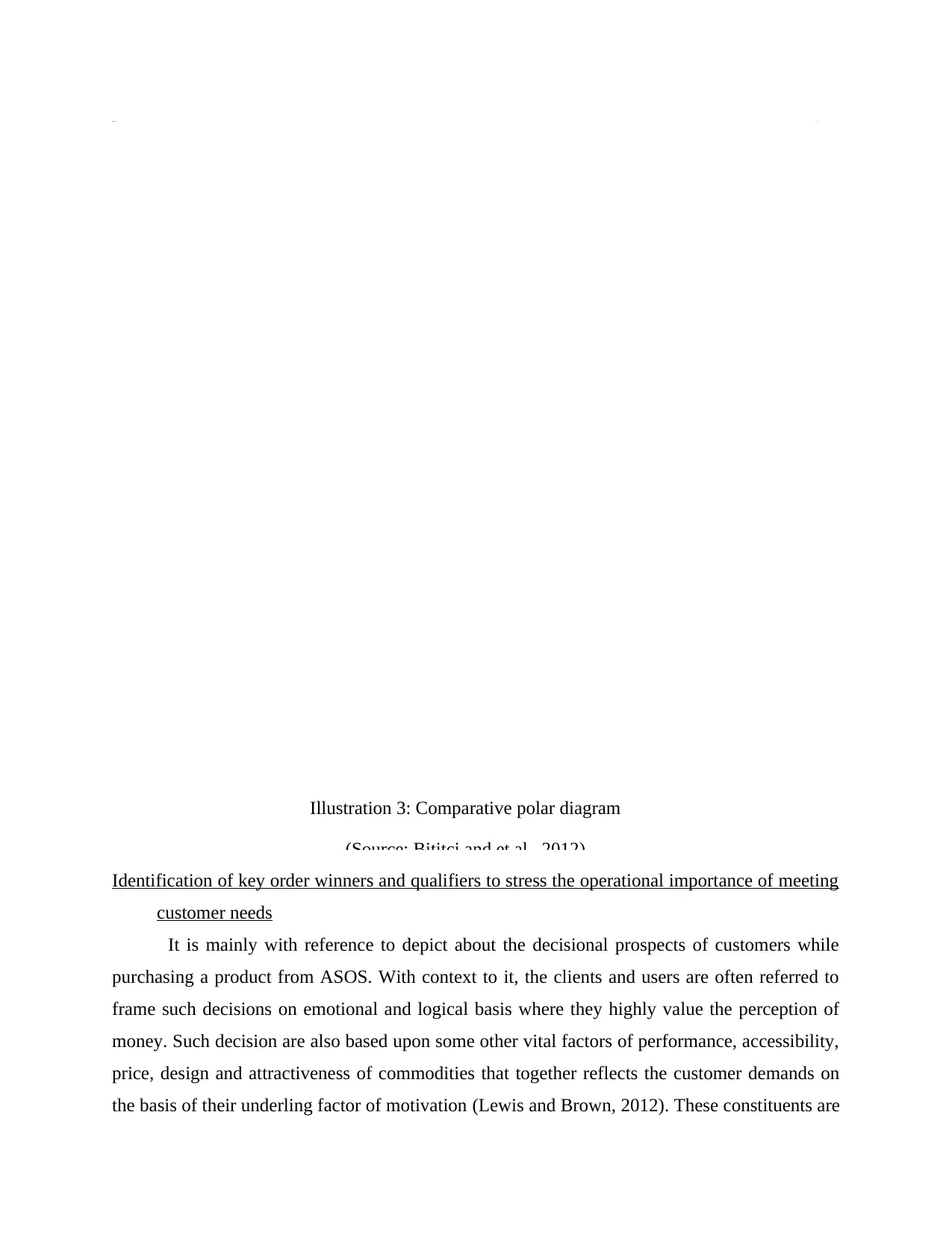
Illustration 3: Comparative polar diagram
(Source: Bititci and et.al., 2012)
Identification of key order winners and qualifiers to stress the operational importance of meeting
customer needs
It is mainly with reference to depict about the decisional prospects of customers while
purchasing a product from ASOS. With context to it, the clients and users are often referred to
frame such decisions on emotional and logical basis where they highly value the perception of
money. Such decision are also based upon some other vital factors of performance, accessibility,
price, design and attractiveness of commodities that together reflects the customer demands on
the basis of their underling factor of motivation (Lewis and Brown, 2012). These constituents are
(Source: Bititci and et.al., 2012)
Identification of key order winners and qualifiers to stress the operational importance of meeting
customer needs
It is mainly with reference to depict about the decisional prospects of customers while
purchasing a product from ASOS. With context to it, the clients and users are often referred to
frame such decisions on emotional and logical basis where they highly value the perception of
money. Such decision are also based upon some other vital factors of performance, accessibility,
price, design and attractiveness of commodities that together reflects the customer demands on
the basis of their underling factor of motivation (Lewis and Brown, 2012). These constituents are
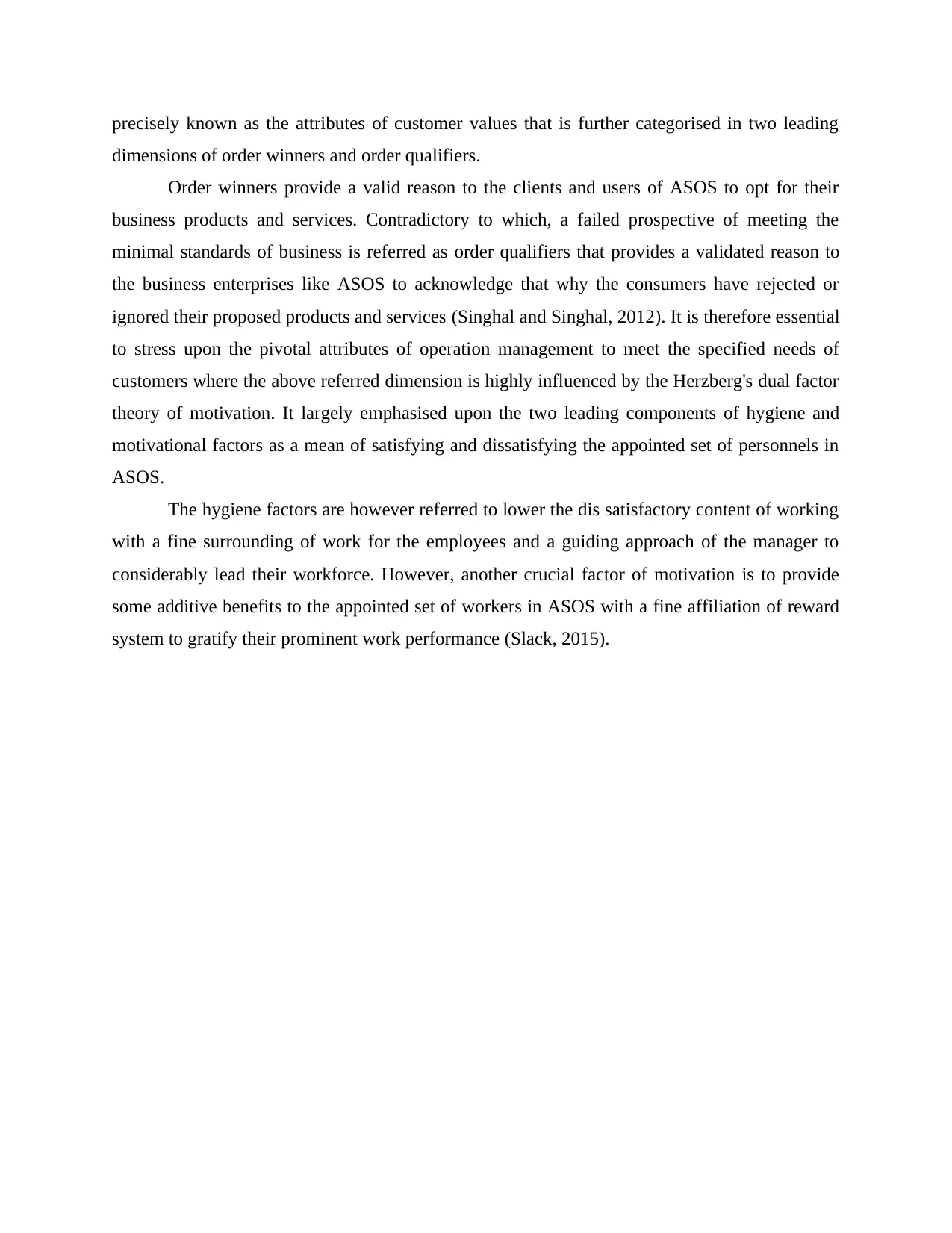
precisely known as the attributes of customer values that is further categorised in two leading
dimensions of order winners and order qualifiers.
Order winners provide a valid reason to the clients and users of ASOS to opt for their
business products and services. Contradictory to which, a failed prospective of meeting the
minimal standards of business is referred as order qualifiers that provides a validated reason to
the business enterprises like ASOS to acknowledge that why the consumers have rejected or
ignored their proposed products and services (Singhal and Singhal, 2012). It is therefore essential
to stress upon the pivotal attributes of operation management to meet the specified needs of
customers where the above referred dimension is highly influenced by the Herzberg's dual factor
theory of motivation. It largely emphasised upon the two leading components of hygiene and
motivational factors as a mean of satisfying and dissatisfying the appointed set of personnels in
ASOS.
The hygiene factors are however referred to lower the dis satisfactory content of working
with a fine surrounding of work for the employees and a guiding approach of the manager to
considerably lead their workforce. However, another crucial factor of motivation is to provide
some additive benefits to the appointed set of workers in ASOS with a fine affiliation of reward
system to gratify their prominent work performance (Slack, 2015).
dimensions of order winners and order qualifiers.
Order winners provide a valid reason to the clients and users of ASOS to opt for their
business products and services. Contradictory to which, a failed prospective of meeting the
minimal standards of business is referred as order qualifiers that provides a validated reason to
the business enterprises like ASOS to acknowledge that why the consumers have rejected or
ignored their proposed products and services (Singhal and Singhal, 2012). It is therefore essential
to stress upon the pivotal attributes of operation management to meet the specified needs of
customers where the above referred dimension is highly influenced by the Herzberg's dual factor
theory of motivation. It largely emphasised upon the two leading components of hygiene and
motivational factors as a mean of satisfying and dissatisfying the appointed set of personnels in
ASOS.
The hygiene factors are however referred to lower the dis satisfactory content of working
with a fine surrounding of work for the employees and a guiding approach of the manager to
considerably lead their workforce. However, another crucial factor of motivation is to provide
some additive benefits to the appointed set of workers in ASOS with a fine affiliation of reward
system to gratify their prominent work performance (Slack, 2015).
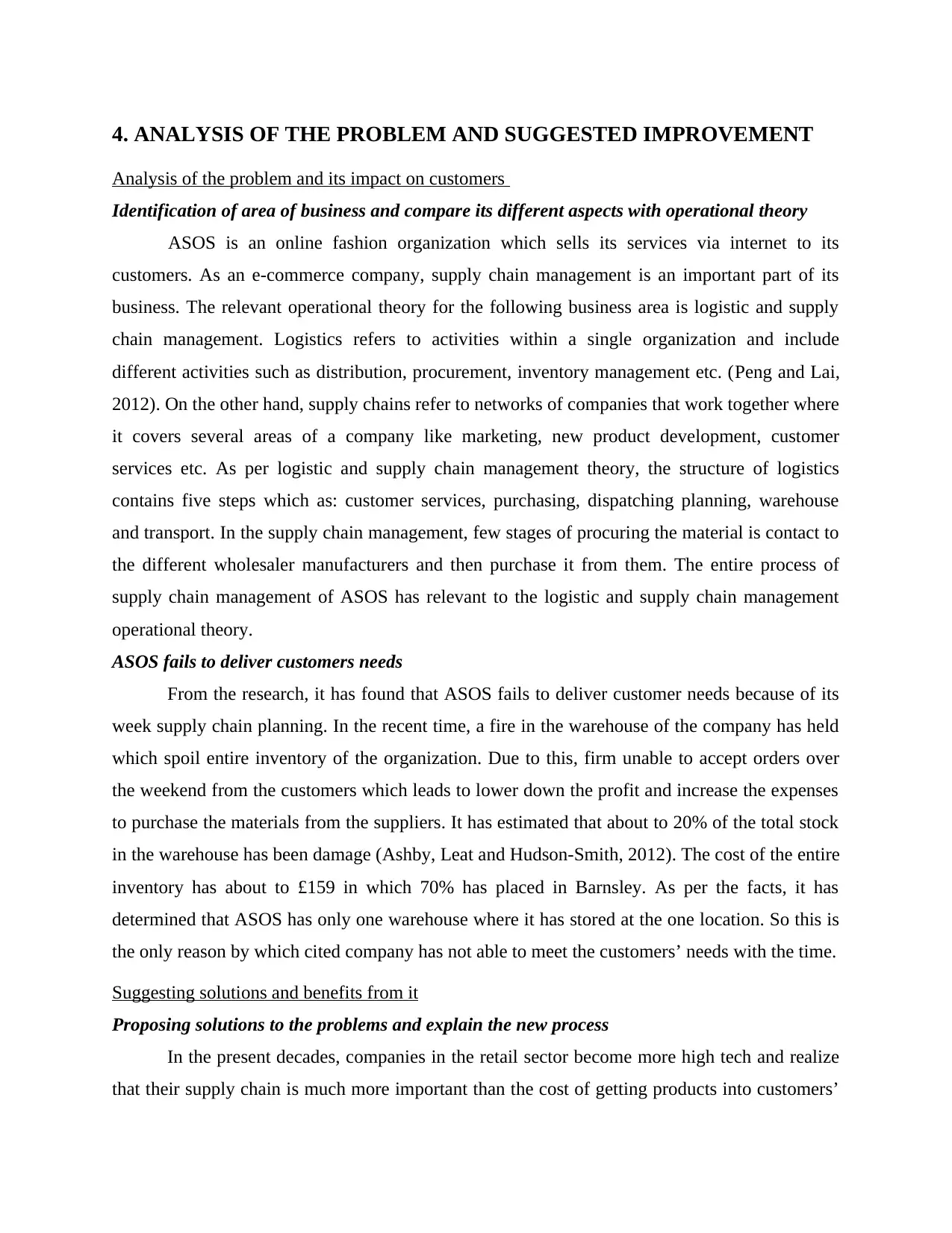
4. ANALYSIS OF THE PROBLEM AND SUGGESTED IMPROVEMENT
Analysis of the problem and its impact on customers
Identification of area of business and compare its different aspects with operational theory
ASOS is an online fashion organization which sells its services via internet to its
customers. As an e-commerce company, supply chain management is an important part of its
business. The relevant operational theory for the following business area is logistic and supply
chain management. Logistics refers to activities within a single organization and include
different activities such as distribution, procurement, inventory management etc. (Peng and Lai,
2012). On the other hand, supply chains refer to networks of companies that work together where
it covers several areas of a company like marketing, new product development, customer
services etc. As per logistic and supply chain management theory, the structure of logistics
contains five steps which as: customer services, purchasing, dispatching planning, warehouse
and transport. In the supply chain management, few stages of procuring the material is contact to
the different wholesaler manufacturers and then purchase it from them. The entire process of
supply chain management of ASOS has relevant to the logistic and supply chain management
operational theory.
ASOS fails to deliver customers needs
From the research, it has found that ASOS fails to deliver customer needs because of its
week supply chain planning. In the recent time, a fire in the warehouse of the company has held
which spoil entire inventory of the organization. Due to this, firm unable to accept orders over
the weekend from the customers which leads to lower down the profit and increase the expenses
to purchase the materials from the suppliers. It has estimated that about to 20% of the total stock
in the warehouse has been damage (Ashby, Leat and Hudson-Smith, 2012). The cost of the entire
inventory has about to £159 in which 70% has placed in Barnsley. As per the facts, it has
determined that ASOS has only one warehouse where it has stored at the one location. So this is
the only reason by which cited company has not able to meet the customers’ needs with the time.
Suggesting solutions and benefits from it
Proposing solutions to the problems and explain the new process
In the present decades, companies in the retail sector become more high tech and realize
that their supply chain is much more important than the cost of getting products into customers’
Analysis of the problem and its impact on customers
Identification of area of business and compare its different aspects with operational theory
ASOS is an online fashion organization which sells its services via internet to its
customers. As an e-commerce company, supply chain management is an important part of its
business. The relevant operational theory for the following business area is logistic and supply
chain management. Logistics refers to activities within a single organization and include
different activities such as distribution, procurement, inventory management etc. (Peng and Lai,
2012). On the other hand, supply chains refer to networks of companies that work together where
it covers several areas of a company like marketing, new product development, customer
services etc. As per logistic and supply chain management theory, the structure of logistics
contains five steps which as: customer services, purchasing, dispatching planning, warehouse
and transport. In the supply chain management, few stages of procuring the material is contact to
the different wholesaler manufacturers and then purchase it from them. The entire process of
supply chain management of ASOS has relevant to the logistic and supply chain management
operational theory.
ASOS fails to deliver customers needs
From the research, it has found that ASOS fails to deliver customer needs because of its
week supply chain planning. In the recent time, a fire in the warehouse of the company has held
which spoil entire inventory of the organization. Due to this, firm unable to accept orders over
the weekend from the customers which leads to lower down the profit and increase the expenses
to purchase the materials from the suppliers. It has estimated that about to 20% of the total stock
in the warehouse has been damage (Ashby, Leat and Hudson-Smith, 2012). The cost of the entire
inventory has about to £159 in which 70% has placed in Barnsley. As per the facts, it has
determined that ASOS has only one warehouse where it has stored at the one location. So this is
the only reason by which cited company has not able to meet the customers’ needs with the time.
Suggesting solutions and benefits from it
Proposing solutions to the problems and explain the new process
In the present decades, companies in the retail sector become more high tech and realize
that their supply chain is much more important than the cost of getting products into customers’
Paraphrase This Document
Need a fresh take? Get an instant paraphrase of this document with our AI Paraphraser
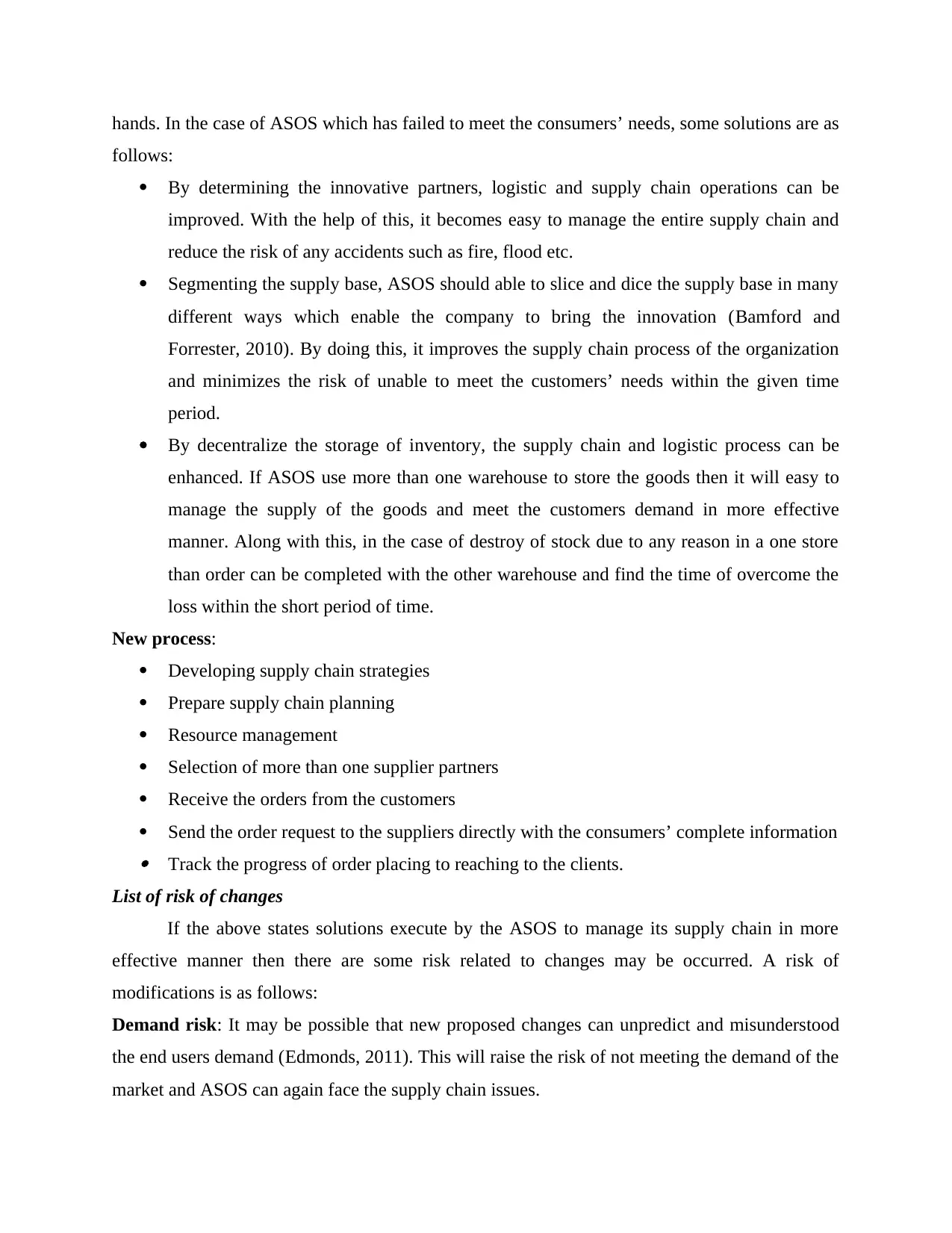
hands. In the case of ASOS which has failed to meet the consumers’ needs, some solutions are as
follows:
By determining the innovative partners, logistic and supply chain operations can be
improved. With the help of this, it becomes easy to manage the entire supply chain and
reduce the risk of any accidents such as fire, flood etc.
Segmenting the supply base, ASOS should able to slice and dice the supply base in many
different ways which enable the company to bring the innovation (Bamford and
Forrester, 2010). By doing this, it improves the supply chain process of the organization
and minimizes the risk of unable to meet the customers’ needs within the given time
period.
By decentralize the storage of inventory, the supply chain and logistic process can be
enhanced. If ASOS use more than one warehouse to store the goods then it will easy to
manage the supply of the goods and meet the customers demand in more effective
manner. Along with this, in the case of destroy of stock due to any reason in a one store
than order can be completed with the other warehouse and find the time of overcome the
loss within the short period of time.
New process:
Developing supply chain strategies
Prepare supply chain planning
Resource management
Selection of more than one supplier partners
Receive the orders from the customers
Send the order request to the suppliers directly with the consumers’ complete information Track the progress of order placing to reaching to the clients.
List of risk of changes
If the above states solutions execute by the ASOS to manage its supply chain in more
effective manner then there are some risk related to changes may be occurred. A risk of
modifications is as follows:
Demand risk: It may be possible that new proposed changes can unpredict and misunderstood
the end users demand (Edmonds, 2011). This will raise the risk of not meeting the demand of the
market and ASOS can again face the supply chain issues.
follows:
By determining the innovative partners, logistic and supply chain operations can be
improved. With the help of this, it becomes easy to manage the entire supply chain and
reduce the risk of any accidents such as fire, flood etc.
Segmenting the supply base, ASOS should able to slice and dice the supply base in many
different ways which enable the company to bring the innovation (Bamford and
Forrester, 2010). By doing this, it improves the supply chain process of the organization
and minimizes the risk of unable to meet the customers’ needs within the given time
period.
By decentralize the storage of inventory, the supply chain and logistic process can be
enhanced. If ASOS use more than one warehouse to store the goods then it will easy to
manage the supply of the goods and meet the customers demand in more effective
manner. Along with this, in the case of destroy of stock due to any reason in a one store
than order can be completed with the other warehouse and find the time of overcome the
loss within the short period of time.
New process:
Developing supply chain strategies
Prepare supply chain planning
Resource management
Selection of more than one supplier partners
Receive the orders from the customers
Send the order request to the suppliers directly with the consumers’ complete information Track the progress of order placing to reaching to the clients.
List of risk of changes
If the above states solutions execute by the ASOS to manage its supply chain in more
effective manner then there are some risk related to changes may be occurred. A risk of
modifications is as follows:
Demand risk: It may be possible that new proposed changes can unpredict and misunderstood
the end users demand (Edmonds, 2011). This will raise the risk of not meeting the demand of the
market and ASOS can again face the supply chain issues.
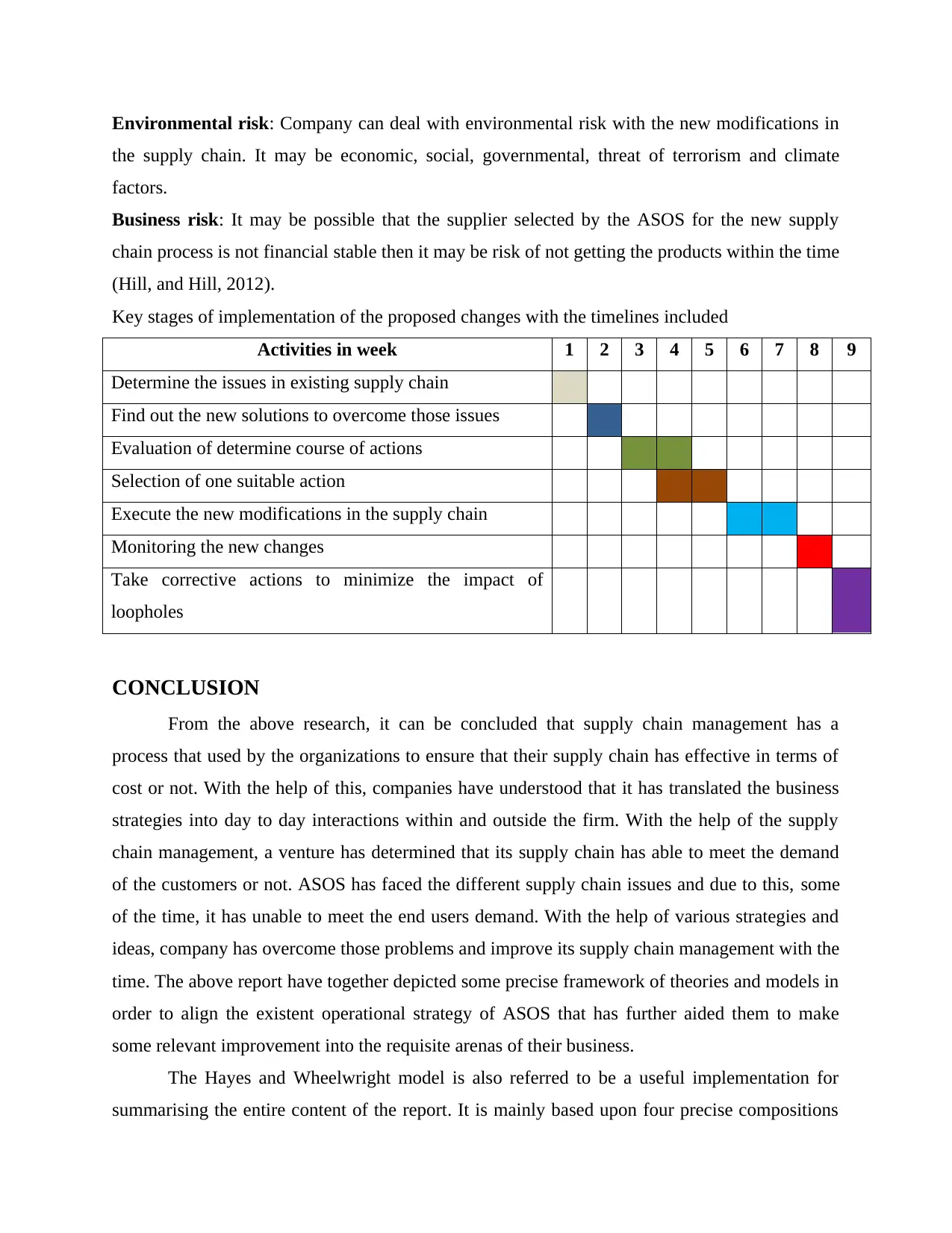
Environmental risk: Company can deal with environmental risk with the new modifications in
the supply chain. It may be economic, social, governmental, threat of terrorism and climate
factors.
Business risk: It may be possible that the supplier selected by the ASOS for the new supply
chain process is not financial stable then it may be risk of not getting the products within the time
(Hill, and Hill, 2012).
Key stages of implementation of the proposed changes with the timelines included
Activities in week 1 2 3 4 5 6 7 8 9
Determine the issues in existing supply chain
Find out the new solutions to overcome those issues
Evaluation of determine course of actions
Selection of one suitable action
Execute the new modifications in the supply chain
Monitoring the new changes
Take corrective actions to minimize the impact of
loopholes
CONCLUSION
From the above research, it can be concluded that supply chain management has a
process that used by the organizations to ensure that their supply chain has effective in terms of
cost or not. With the help of this, companies have understood that it has translated the business
strategies into day to day interactions within and outside the firm. With the help of the supply
chain management, a venture has determined that its supply chain has able to meet the demand
of the customers or not. ASOS has faced the different supply chain issues and due to this, some
of the time, it has unable to meet the end users demand. With the help of various strategies and
ideas, company has overcome those problems and improve its supply chain management with the
time. The above report have together depicted some precise framework of theories and models in
order to align the existent operational strategy of ASOS that has further aided them to make
some relevant improvement into the requisite arenas of their business.
The Hayes and Wheelwright model is also referred to be a useful implementation for
summarising the entire content of the report. It is mainly based upon four precise compositions
the supply chain. It may be economic, social, governmental, threat of terrorism and climate
factors.
Business risk: It may be possible that the supplier selected by the ASOS for the new supply
chain process is not financial stable then it may be risk of not getting the products within the time
(Hill, and Hill, 2012).
Key stages of implementation of the proposed changes with the timelines included
Activities in week 1 2 3 4 5 6 7 8 9
Determine the issues in existing supply chain
Find out the new solutions to overcome those issues
Evaluation of determine course of actions
Selection of one suitable action
Execute the new modifications in the supply chain
Monitoring the new changes
Take corrective actions to minimize the impact of
loopholes
CONCLUSION
From the above research, it can be concluded that supply chain management has a
process that used by the organizations to ensure that their supply chain has effective in terms of
cost or not. With the help of this, companies have understood that it has translated the business
strategies into day to day interactions within and outside the firm. With the help of the supply
chain management, a venture has determined that its supply chain has able to meet the demand
of the customers or not. ASOS has faced the different supply chain issues and due to this, some
of the time, it has unable to meet the end users demand. With the help of various strategies and
ideas, company has overcome those problems and improve its supply chain management with the
time. The above report have together depicted some precise framework of theories and models in
order to align the existent operational strategy of ASOS that has further aided them to make
some relevant improvement into the requisite arenas of their business.
The Hayes and Wheelwright model is also referred to be a useful implementation for
summarising the entire content of the report. It is mainly based upon four precise compositions
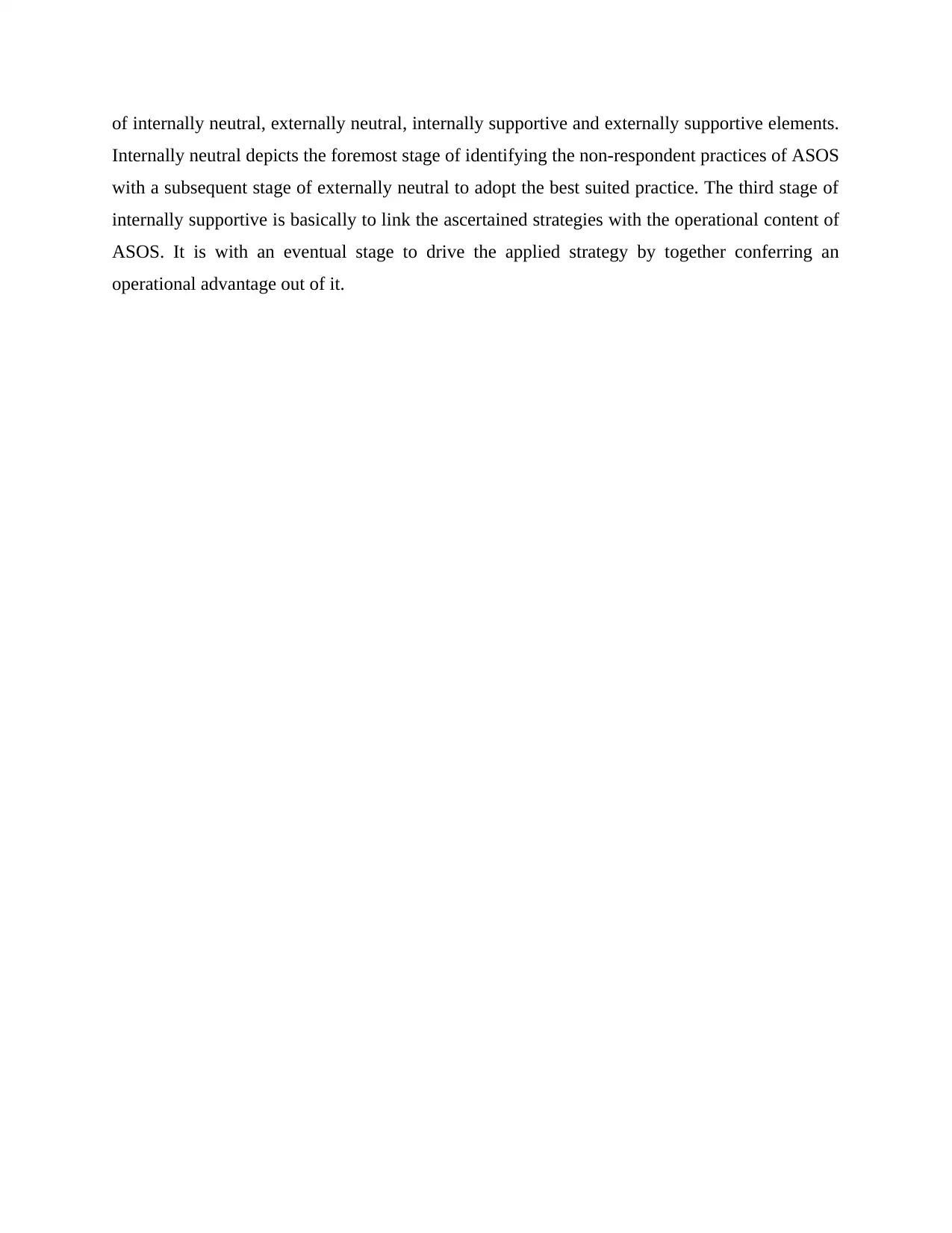
of internally neutral, externally neutral, internally supportive and externally supportive elements.
Internally neutral depicts the foremost stage of identifying the non-respondent practices of ASOS
with a subsequent stage of externally neutral to adopt the best suited practice. The third stage of
internally supportive is basically to link the ascertained strategies with the operational content of
ASOS. It is with an eventual stage to drive the applied strategy by together conferring an
operational advantage out of it.
Internally neutral depicts the foremost stage of identifying the non-respondent practices of ASOS
with a subsequent stage of externally neutral to adopt the best suited practice. The third stage of
internally supportive is basically to link the ascertained strategies with the operational content of
ASOS. It is with an eventual stage to drive the applied strategy by together conferring an
operational advantage out of it.
Secure Best Marks with AI Grader
Need help grading? Try our AI Grader for instant feedback on your assignments.
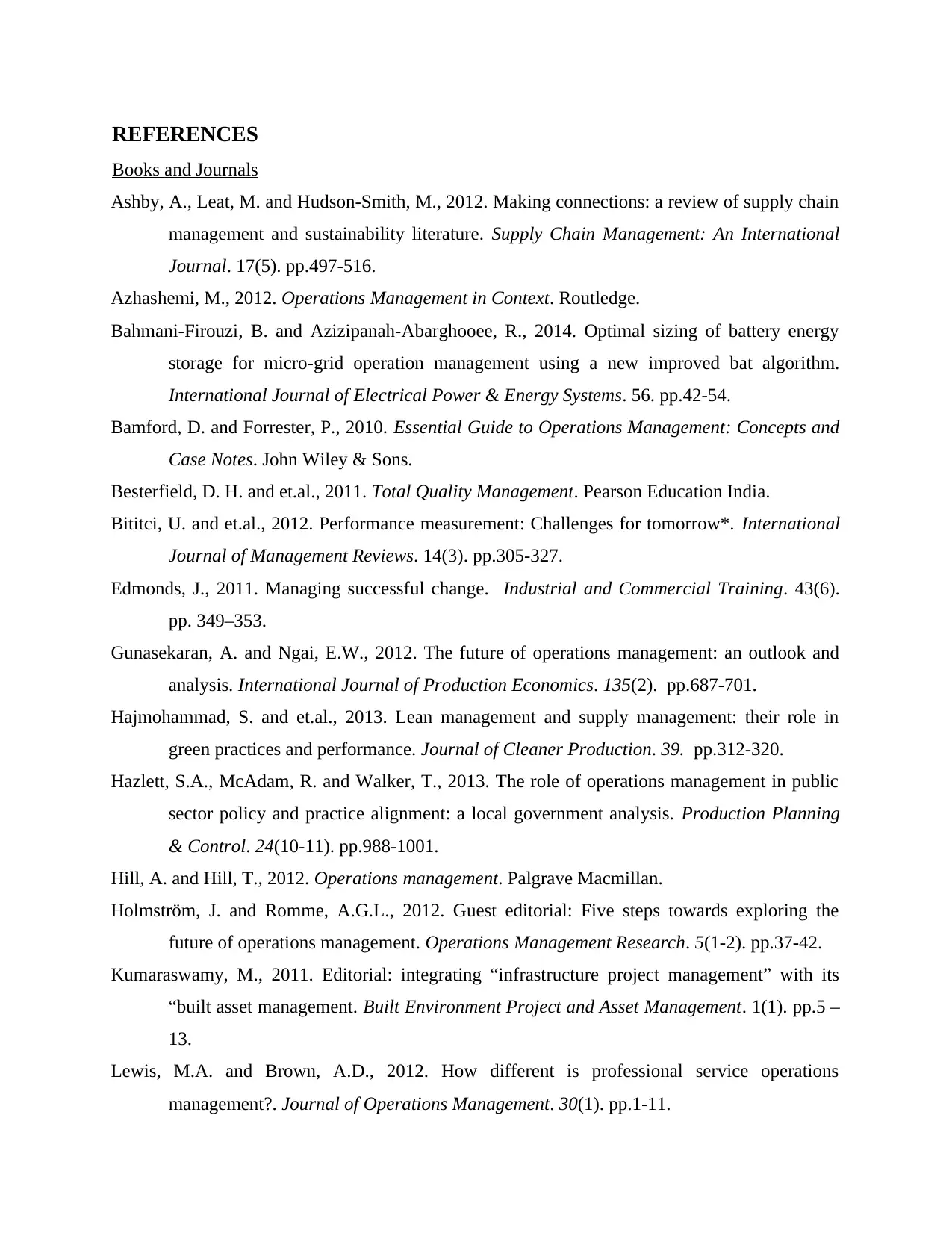
REFERENCES
Books and Journals
Ashby, A., Leat, M. and Hudson-Smith, M., 2012. Making connections: a review of supply chain
management and sustainability literature. Supply Chain Management: An International
Journal. 17(5). pp.497-516.
Azhashemi, M., 2012. Operations Management in Context. Routledge.
Bahmani-Firouzi, B. and Azizipanah-Abarghooee, R., 2014. Optimal sizing of battery energy
storage for micro-grid operation management using a new improved bat algorithm.
International Journal of Electrical Power & Energy Systems. 56. pp.42-54.
Bamford, D. and Forrester, P., 2010. Essential Guide to Operations Management: Concepts and
Case Notes. John Wiley & Sons.
Besterfield, D. H. and et.al., 2011. Total Quality Management. Pearson Education India.
Bititci, U. and et.al., 2012. Performance measurement: Challenges for tomorrow*. International
Journal of Management Reviews. 14(3). pp.305-327.
Edmonds, J., 2011. Managing successful change. Industrial and Commercial Training. 43(6).
pp. 349–353.
Gunasekaran, A. and Ngai, E.W., 2012. The future of operations management: an outlook and
analysis. International Journal of Production Economics. 135(2). pp.687-701.
Hajmohammad, S. and et.al., 2013. Lean management and supply management: their role in
green practices and performance. Journal of Cleaner Production. 39. pp.312-320.
Hazlett, S.A., McAdam, R. and Walker, T., 2013. The role of operations management in public
sector policy and practice alignment: a local government analysis. Production Planning
& Control. 24(10-11). pp.988-1001.
Hill, A. and Hill, T., 2012. Operations management. Palgrave Macmillan.
Holmström, J. and Romme, A.G.L., 2012. Guest editorial: Five steps towards exploring the
future of operations management. Operations Management Research. 5(1-2). pp.37-42.
Kumaraswamy, M., 2011. Editorial: integrating “infrastructure project management” with its
“built asset management. Built Environment Project and Asset Management. 1(1). pp.5 –
13.
Lewis, M.A. and Brown, A.D., 2012. How different is professional service operations
management?. Journal of Operations Management. 30(1). pp.1-11.
Books and Journals
Ashby, A., Leat, M. and Hudson-Smith, M., 2012. Making connections: a review of supply chain
management and sustainability literature. Supply Chain Management: An International
Journal. 17(5). pp.497-516.
Azhashemi, M., 2012. Operations Management in Context. Routledge.
Bahmani-Firouzi, B. and Azizipanah-Abarghooee, R., 2014. Optimal sizing of battery energy
storage for micro-grid operation management using a new improved bat algorithm.
International Journal of Electrical Power & Energy Systems. 56. pp.42-54.
Bamford, D. and Forrester, P., 2010. Essential Guide to Operations Management: Concepts and
Case Notes. John Wiley & Sons.
Besterfield, D. H. and et.al., 2011. Total Quality Management. Pearson Education India.
Bititci, U. and et.al., 2012. Performance measurement: Challenges for tomorrow*. International
Journal of Management Reviews. 14(3). pp.305-327.
Edmonds, J., 2011. Managing successful change. Industrial and Commercial Training. 43(6).
pp. 349–353.
Gunasekaran, A. and Ngai, E.W., 2012. The future of operations management: an outlook and
analysis. International Journal of Production Economics. 135(2). pp.687-701.
Hajmohammad, S. and et.al., 2013. Lean management and supply management: their role in
green practices and performance. Journal of Cleaner Production. 39. pp.312-320.
Hazlett, S.A., McAdam, R. and Walker, T., 2013. The role of operations management in public
sector policy and practice alignment: a local government analysis. Production Planning
& Control. 24(10-11). pp.988-1001.
Hill, A. and Hill, T., 2012. Operations management. Palgrave Macmillan.
Holmström, J. and Romme, A.G.L., 2012. Guest editorial: Five steps towards exploring the
future of operations management. Operations Management Research. 5(1-2). pp.37-42.
Kumaraswamy, M., 2011. Editorial: integrating “infrastructure project management” with its
“built asset management. Built Environment Project and Asset Management. 1(1). pp.5 –
13.
Lewis, M.A. and Brown, A.D., 2012. How different is professional service operations
management?. Journal of Operations Management. 30(1). pp.1-11.
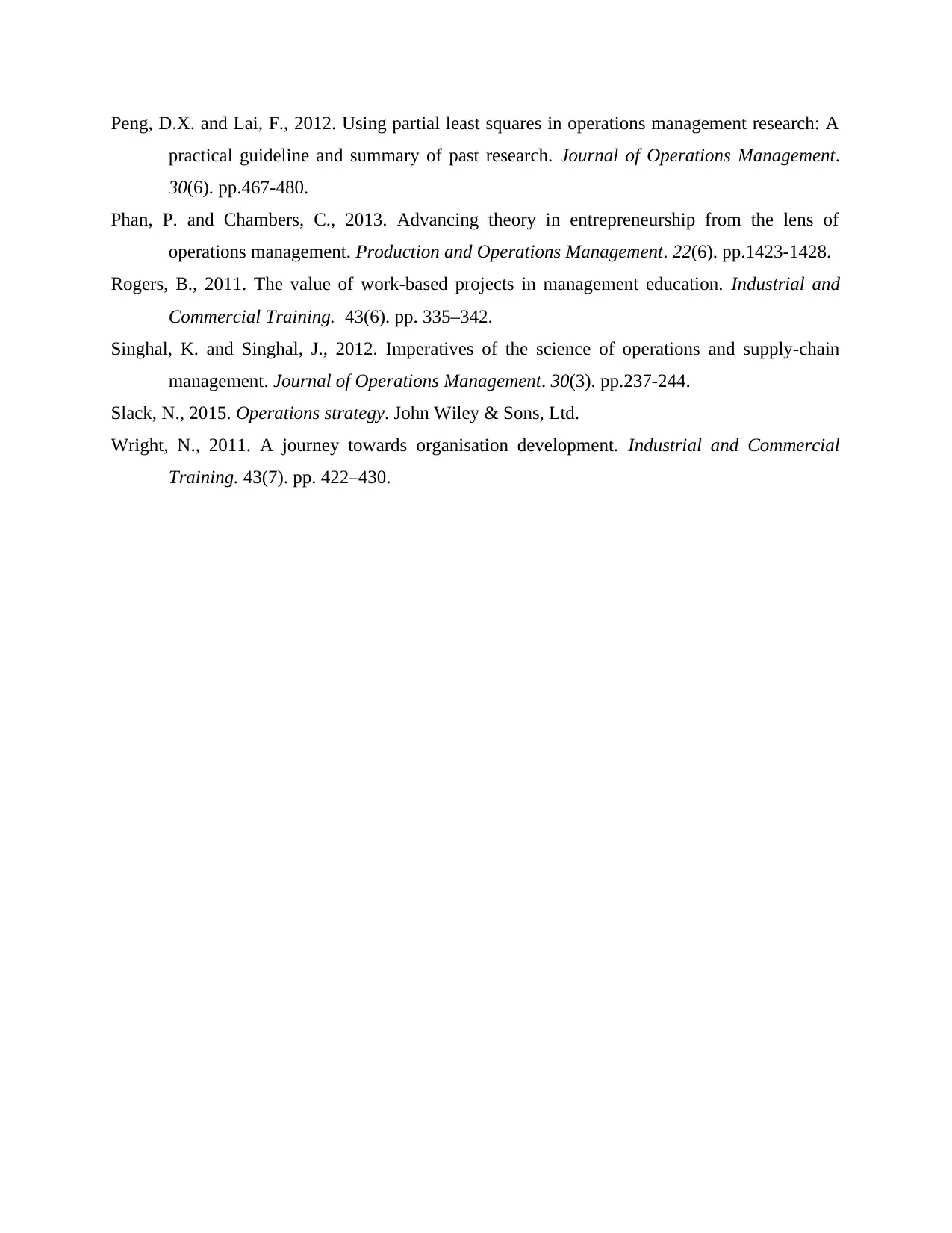
Peng, D.X. and Lai, F., 2012. Using partial least squares in operations management research: A
practical guideline and summary of past research. Journal of Operations Management.
30(6). pp.467-480.
Phan, P. and Chambers, C., 2013. Advancing theory in entrepreneurship from the lens of
operations management. Production and Operations Management. 22(6). pp.1423-1428.
Rogers, B., 2011. The value of work‐based projects in management education. Industrial and
Commercial Training. 43(6). pp. 335–342.
Singhal, K. and Singhal, J., 2012. Imperatives of the science of operations and supply-chain
management. Journal of Operations Management. 30(3). pp.237-244.
Slack, N., 2015. Operations strategy. John Wiley & Sons, Ltd.
Wright, N., 2011. A journey towards organisation development. Industrial and Commercial
Training. 43(7). pp. 422–430.
practical guideline and summary of past research. Journal of Operations Management.
30(6). pp.467-480.
Phan, P. and Chambers, C., 2013. Advancing theory in entrepreneurship from the lens of
operations management. Production and Operations Management. 22(6). pp.1423-1428.
Rogers, B., 2011. The value of work‐based projects in management education. Industrial and
Commercial Training. 43(6). pp. 335–342.
Singhal, K. and Singhal, J., 2012. Imperatives of the science of operations and supply-chain
management. Journal of Operations Management. 30(3). pp.237-244.
Slack, N., 2015. Operations strategy. John Wiley & Sons, Ltd.
Wright, N., 2011. A journey towards organisation development. Industrial and Commercial
Training. 43(7). pp. 422–430.
1 out of 18
Related Documents
Your All-in-One AI-Powered Toolkit for Academic Success.
+13062052269
info@desklib.com
Available 24*7 on WhatsApp / Email
![[object Object]](/_next/static/media/star-bottom.7253800d.svg)
Unlock your academic potential
© 2024 | Zucol Services PVT LTD | All rights reserved.





